Ready to see the spectacular Mighty 5? This ultimate Utah national parks road trip takes you on a stunning loop through some of the most majestic landscapes you will find anywhere in the United States.
You’ll see Zion National Park, Bryce Canyon National Park, Arches National Park, Canyonlands National Park, and Capitol Reef National Park.
I’ll also cover one bonus state park I highly recommend you include in your itinerary: Dead Horse Point State Park. (What a name, huh?)
Keep reading for where to stay, what to pack, and insider tips on the best way to see each park with fewer crowds and limited time.
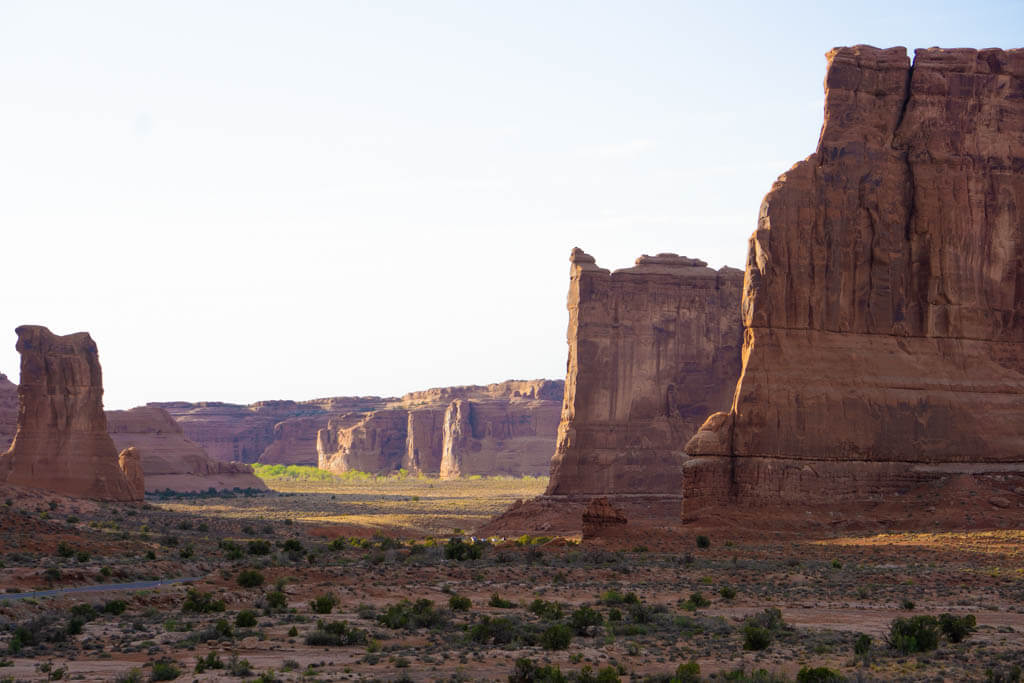
Contents
- Mighty Five Road Trip
- Planning a Trip to Utah’s National Parks
- National Parks Packing List
- Utah Mighty 5 Road Trip Map
- Day 1: Zion National Park—Explore the Valley
- Best Time to Visit Utah National Parks
- Day 2: Zion National Park—Take a Bucket List Hike
- Day 3: Bryce Canyon National Park
- Day 4: Moab
- Day 5: Arches National Park
- Day 6: Canyonlands National Park
- BONUS: Dead Horse Point State Park
- Day 7: Explore Fruita at Capitol Reef National Park
- The Grand Staircase: A Geological Wonder
- Day 8: Hike in Capitol Reef National Park
- Road Trip to Utah National Parks
Mighty Five Road Trip
Planning a Trip to Utah’s National Parks
The first question is: How long have you got? When planning your road trip to Utah national parks, the ideal amount of time is 10 days. Plan one day to fly in, one day to fly out and eight days to explore The Mighty 5. It’s one of the best Utah road trips there is! For more hiking, spend two weeks as we did.
This 10 day road trip itinerary and guide to Utah national parks begins in Las Vegas. We drove from home in San Diego. Las Vegas makes the most convenient airport to fly into (but Salt Lake City works too).
If you only have one week and are hoping to see five parks, just know that you’re going to be rushed.
It’s also a five-hour drive between the two furthest parks—Zion National Park to the south and Canyonlands in the north—so you’ll need to factor that in.
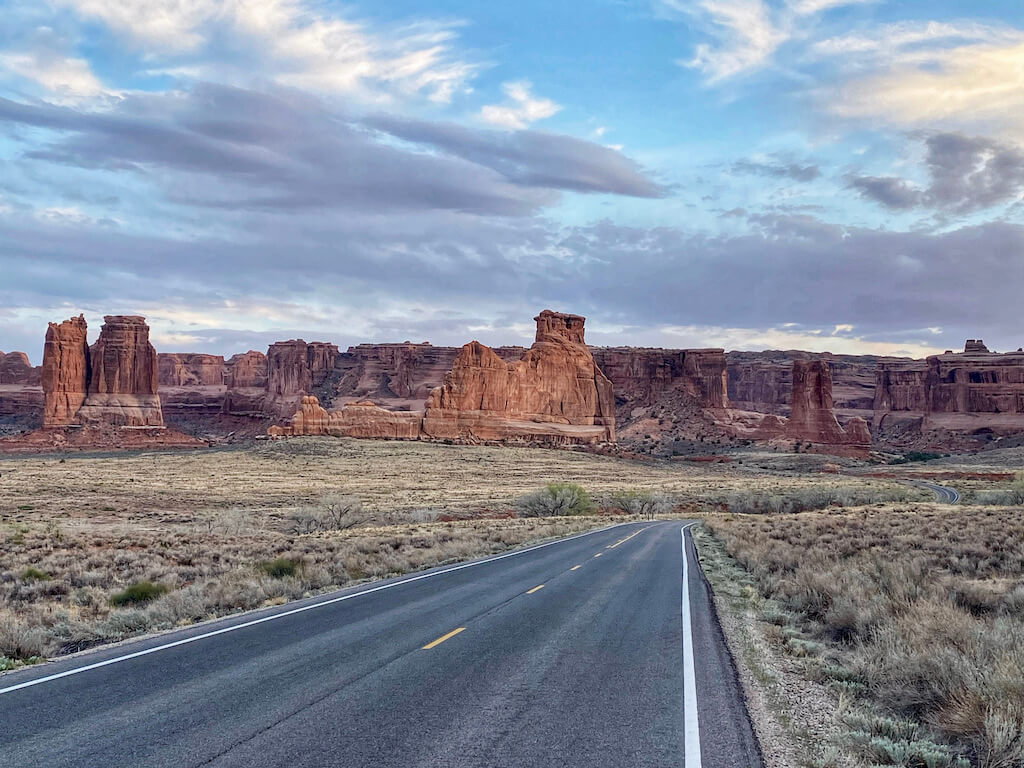
National Parks Packing List
You can find a more comprehensive list of items I recommend on my Yellowstone packing list, but here are some specifics for your Utah national parks road trip:
• Water bottle—Stay hydrated! Serious hikers may want to invest in a bladder with 2L to 3 L capacity. Otherwise, I like the BPA-free CamelBak water bottles. Get one on Amazon here.
• Sunscreen—Avoid sunburn with an SPF 50 sunscreen. You can grab it on Amazon here.
• Sunglasses— Don’t forget these! My pick is on Amazon here.
• Sun hat— Columbia’s unisex hat is made of moisture-wicking fabric. Get one on Amazon here.
• Water shoes—Keens are my go-to shoes if hikes also include rivers and mud! Check them out on Amazon here.
• Hiking boots—It’s easy to slip if you wear tennis shoes hiking in Red Rock Country. My Ahnu hiking boots are low profile and lightweight. Get yours on Amazon here.
• Binoculars—We upgraded to Vortex Optics when whale watching in the PNW last summer and they are amazing. See them on Amazon here.
• Day pack—Get one that’s slim and lightweight. The Osprey daypack on Amazon is ideal.
• Headlamp—This is Dark Sky country! If you’ll be in the parks late at night stargazing or shooting the night sky with your camera, you need a headlamp. Get one on Amazon here.
Personally, if you only have a single week to road trip Utah, I’d recommend saving several parks for your next visit.
One itinerary idea for just seven days is to fly into Salt Lake City, make the four-hour drive to Moab and base there for three or four days.
You can easily day trip to Arches National Park, Canyonlands, and Dead Horse Point State Park (which is incredible).
Beautiful hikes, mountain biking, and other adventure activities abound in Moab. (More on that below.)
Then spend the balance of your week at incredible Capitol Reef Park, two hours south. I wish we’d had more time at Capitol Reef!
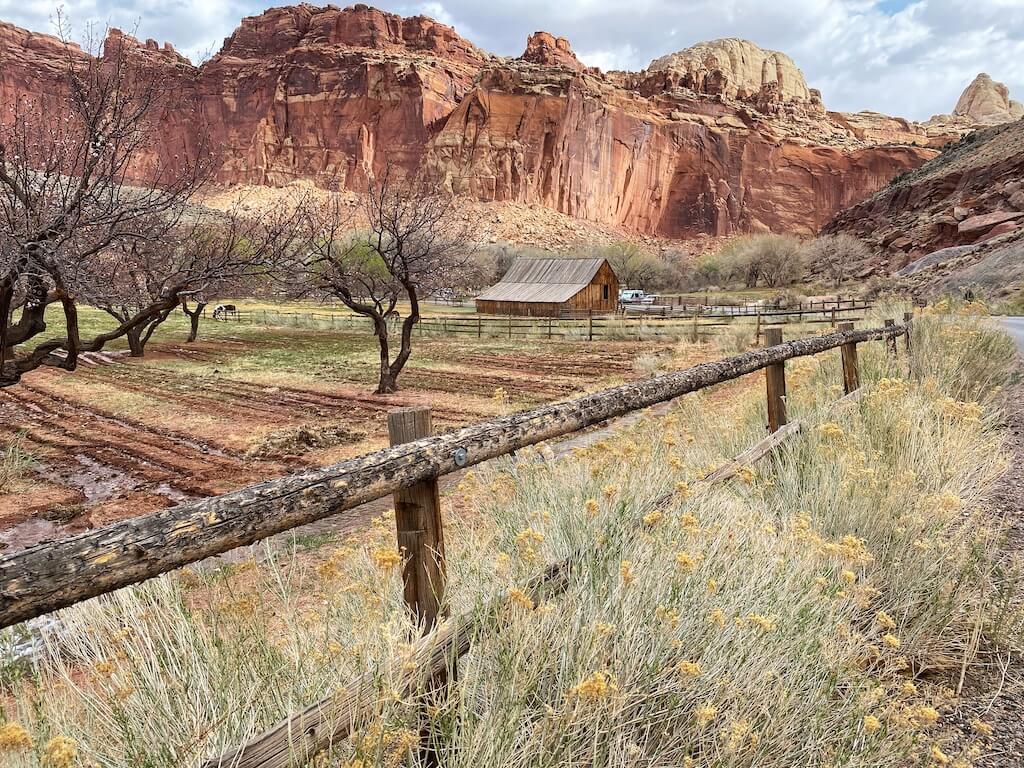
With 10 days, I recommend planning one day to fly or drive to Zion, one day to fly or drive back and then organizing the remaining 8 days in the middle like this:
• Day 1 & 2: Zion National Park
• Day 3: Bryce Canyon National Park
• Day 4: Drive to Moab, hike or cycle Moab
• Day 5: Arches National Park
• Day 6: Canyonlands National Park
• Day 7 & 8: Capitol Reef National Park
• BONUS day: Dead Horse Point State Park—(not part of The Mighty 5. You can also combine this with a visit to Canyonlands).
Save on Your Mighty 5 Parks Visit: Get an Annual Pass
With an annual pass to US national parks, you’ll save $70 on this trip alone…even if you never visit another park all year.
Here’s the breakdown: Entrance fees to these 5 Utah national parks cost $150 in total. The pass is $79.99 (and includes access to 2,000 federal recreation sites nationwide).
It covers entrance for a driver and all passengers in a personal vehicle or up to 4 adults at sites that charge per person. When you buy through REI, they donate 10 percent of the sale to the National Park Foundation.
Get your America the Beautiful Pass at REI here.
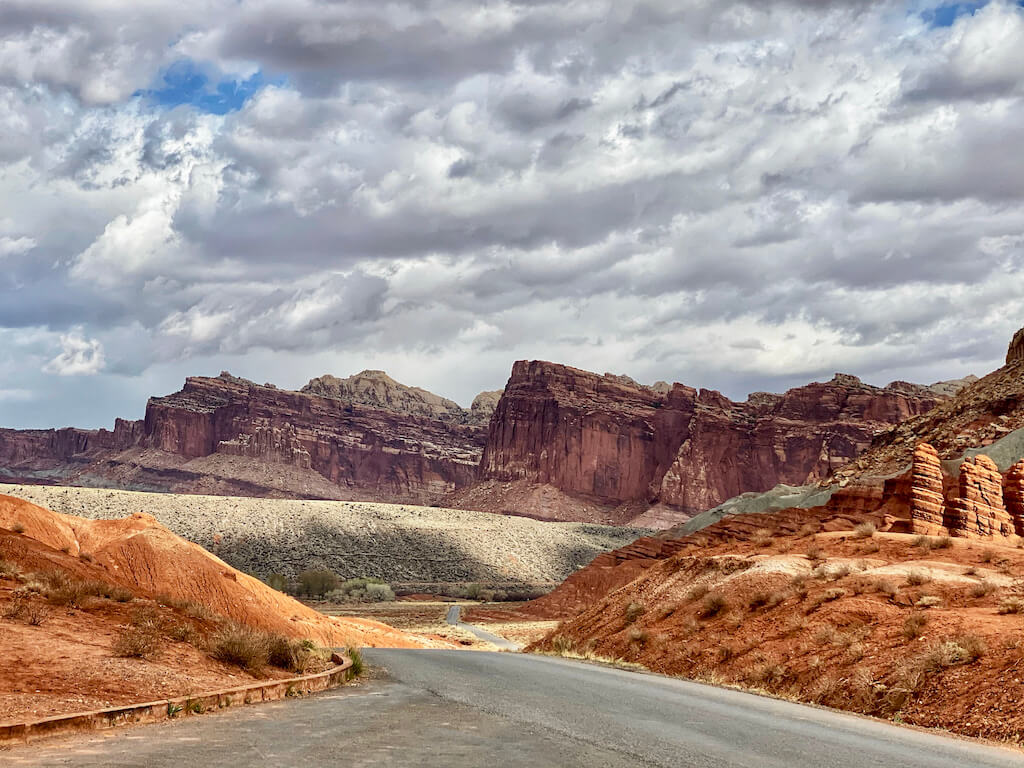
The best southern Utah road trip also includes one day hiking or mountain biking at Dead Horse State Park near Canyonlands. It’s honestly as phenomenal as the other Utah national parks I’ve listed above.
That makes eight days of parks and two days of driving/flying there and home.
Utah Mighty 5 Road Trip Map
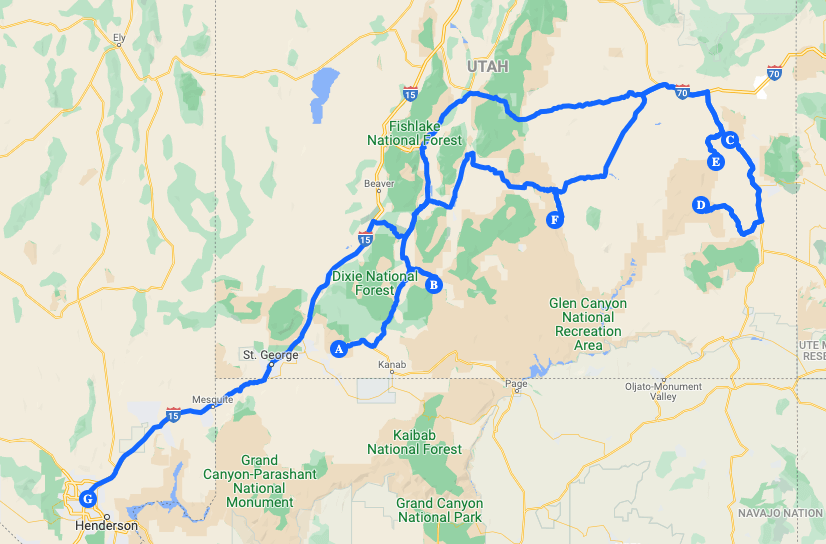
How to use this map: This map is an image. Click the map to open an interactive version of the map. From there, if you click “open in my maps”, you can add this to your Google maps. Just click the tiny transparent star to the right of the map description to save it in “your places.” Go to “your places” next and there it is!
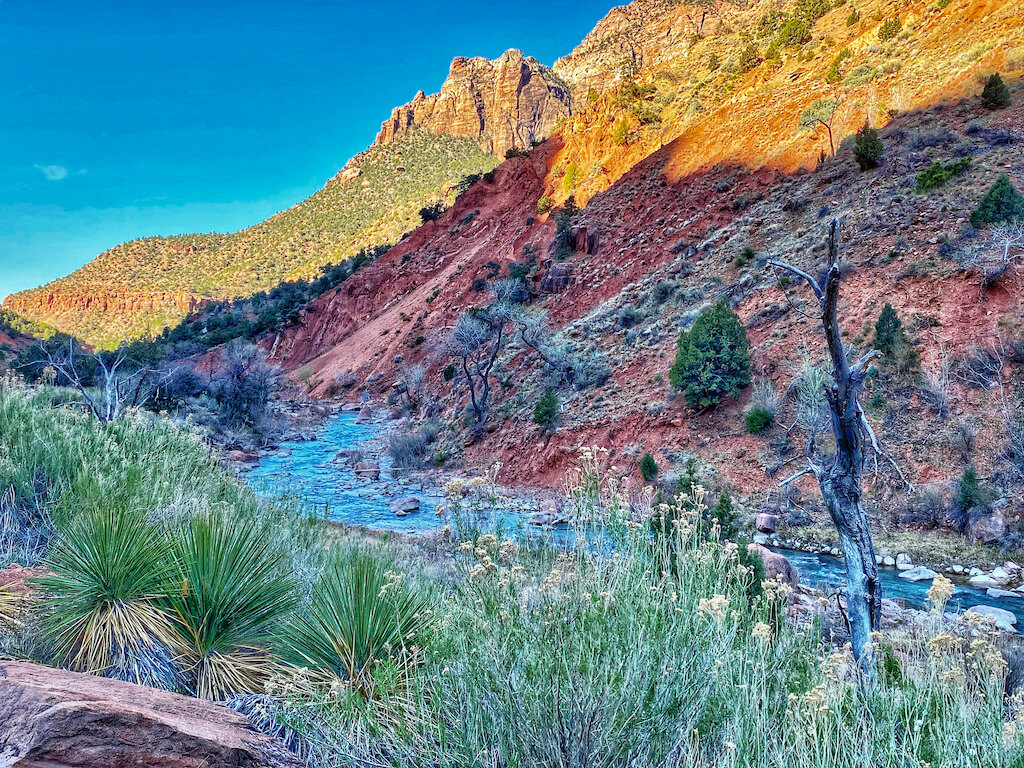
Day 1: Zion National Park—Explore the Valley
This was my third visit to Zion National Park and honestly, I love it more with every visit.
It’s small and compact with one main road—Zion Canyon Scenic Drive—cutting through the valley floor along the beautiful Virgin River.
Steep sandstone cliffs—swirling cream, red, and pink—jut into the sky and surround you on both sides of this narrow canyon.
One of the best ways to fully appreciate the beauty is here is by bicycle.
How to Take the Zion Shuttle
It’s important to know that between late November and March, Zion Canyon Scenic Drive—the main road through the valley where the majority of trails are—is closed to private vehicles.
However, free shuttles leave every few minutes in both directions. Thankfully, shuttle tickets/reservations are no longer required as they were in spring and summer 2021!
Shuttles run between 7 am and 5:45 pm. They’re easy and convenient. Just get on or off at any stop.
Zion National Park is ideal for cycling.
We brought our two e-bikes on our road trip and probably enjoyed them most in Zion over any other of the parks we visited.
In high season (April to October), no cars are allowed into the park which made it delightfully traffic-free.
Truly, it’s a wonderful way to see the park! If you don’t have your own e-bikes, join the craze by renting one near the south entrance to the park in Springdale at Zion Peddler.
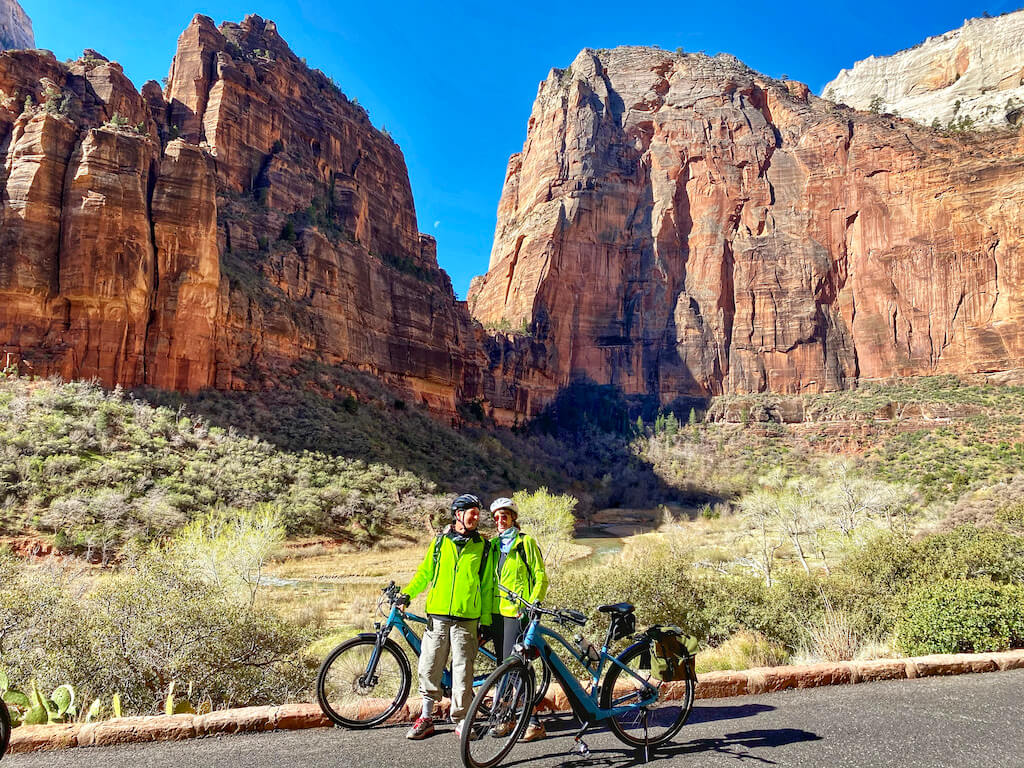
We started on the paved Pa’rus Trail (also for pedestrians), crisscrossing the Virgin River over bridges and stopped for lunch at the Zion Lodge (really excellent food here especially as compared to other parks like Bryce, which I’d give a miss for dining).
We then continued along the road to the end of the valley. Round-trip, it was probably a two-hour ride on flat terrain.
It’s also super convenient to lock your bike for hikes near all the trailheads thanks to the abundant bike racks.
Plus, if you prefer to ride a regular bike and want a lift back, you can just toss your bike on the shuttle rack.
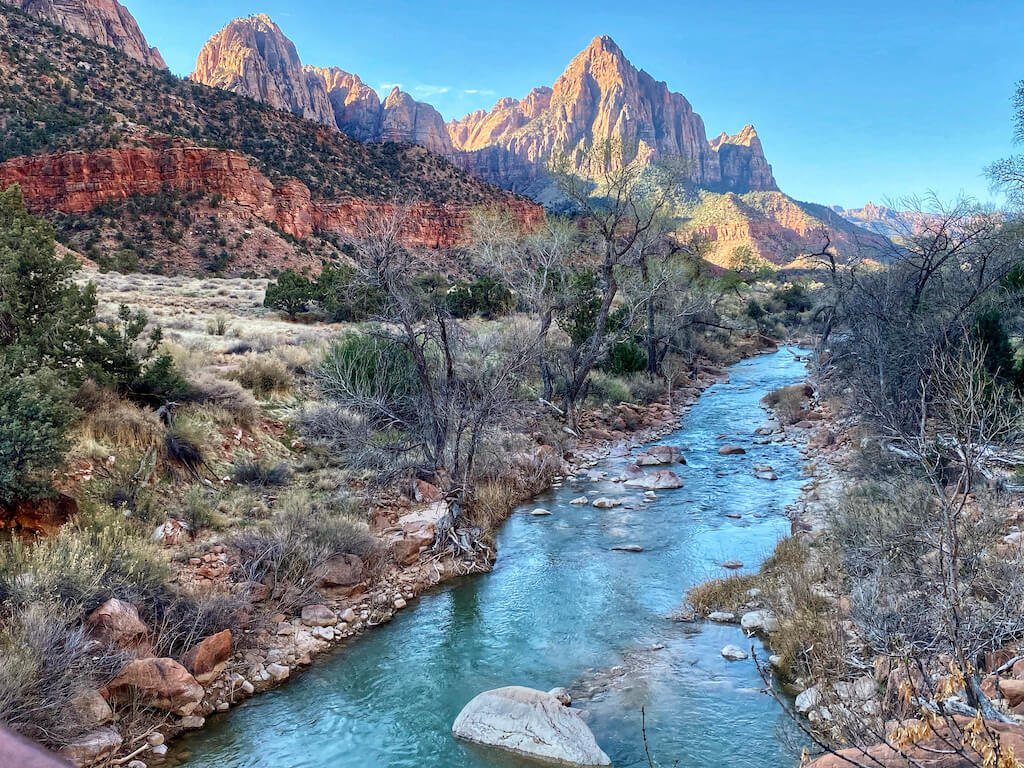
Where to catch sunset
The best-known spot in Zion to watch the sunset is the famous Angel’s Landing Hike. More about that on Day 2.
However, if the idea of that hike leaves you a little woozy (as it does me) or you’re looking for epic sunset views on both of your days in Zion, head up to the Canyon Overlook Trail in the Upper East Canyon.
This trail has quite the pay-off for a view but unlike Angel’s Landing, there’s just a short initial gain in elevation as you climb a set of stairs.
There are also plenty of rails and it’s short! Just one-mile round-trip, which will take you only 30 minutes to an hour.
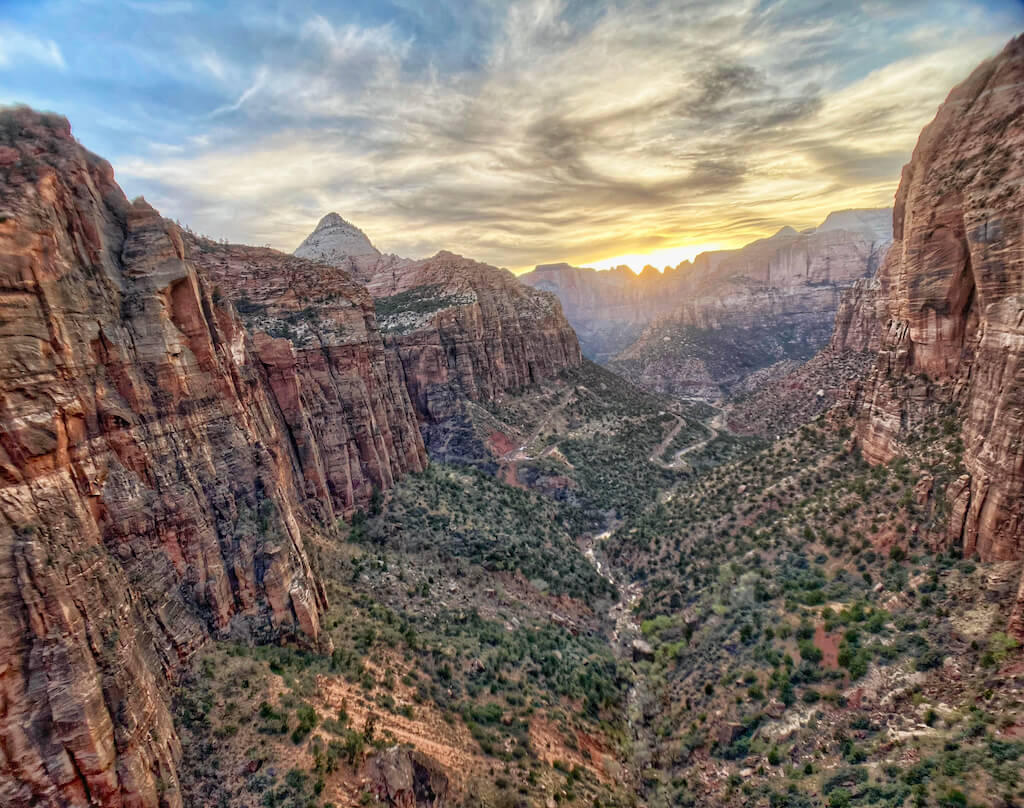
A couple of tips: You’ll need to drive here. Fortunately, this area is accessible by car all year round.
As soon as you come through the tunnel, you’ll see a small parking lot on the left (coming from the south).
If you didn’t arrive early enough, there’s a good chance this parking lot will be full so just look for a spot on the side of the highway and park there.
You’ll find quite a crowd at the top and it can be a little tricky to navigate the steps in the dark so either wear a headlamp or leave before everybody else does!
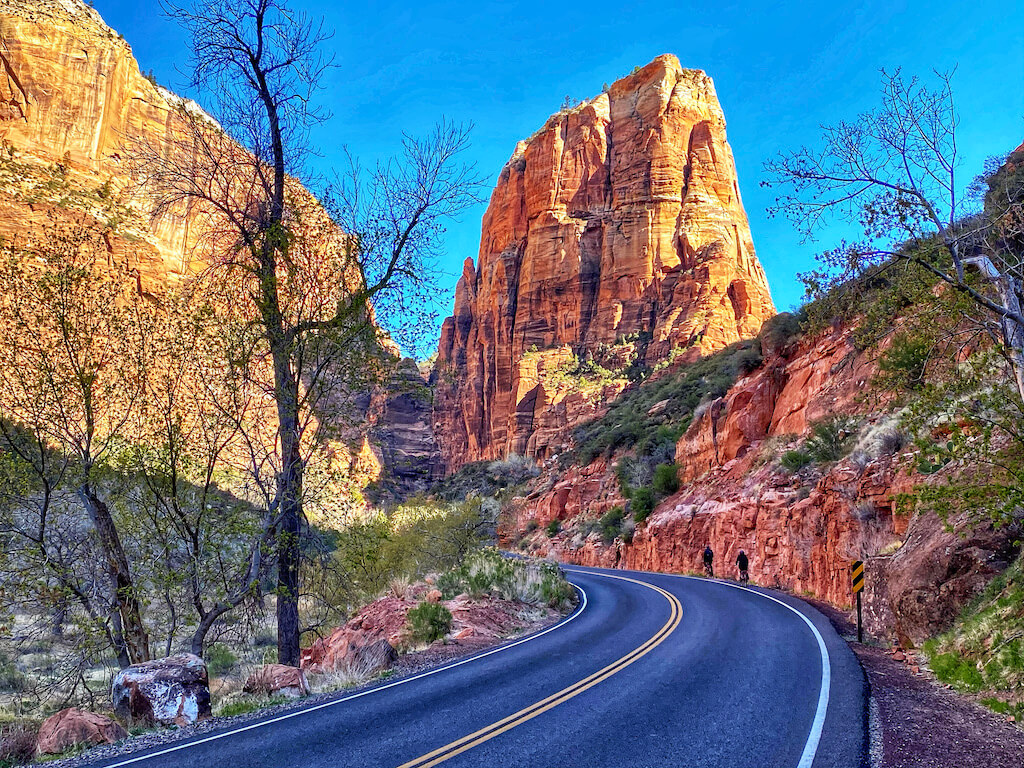
Best Time to Visit Utah National Parks
Spring and fall are the best time to visit the Mighty 5. You’ll find the best weather in April to May and also in September to October.
Enjoy wildflowers in spring and fall foliage late in the season. Despite extreme temps in summer (100 degrees F plus), this season can be extremely busy with tourists.
Day 2: Zion National Park—Take a Bucket List Hike
Now that you’ve taken the lay of the land, it’s time to get out into nature. Save one day at Zion for an epic hike.
If you’re a serious hiker, you’ve probably heard about two incredible hikes here. Here are more details on these options:
Option 1: The Narrows
There are numerous ways to hike it, but by far, the most popular is “bottom up”, accessing the trail from the Temple of Sinawava.
This is the last shuttle stop up to Big Springs and then along the Riverside Walk (the paved trail along the river).
This is a full-day hike through a narrow slot canyon—walking up to 8.9 miles out and back through the Virgin River. It takes up to six hours, depending on how far you go.
If you do this hike, be sure to make it to the Wall Street section of the canyon where sandstone cliffs rise up 1500 feet with just 22 feet of river between them!

Tips for hiking the Narrows: Tip #1: If you’re going to spend all day hiking through a river, you’re going to want the right equipment.
Walking on algae-coated rocks can feel like walking on a slippery bowling ball so be sure you have sturdy footwear, trekking poles, and extra layers of warm clothing in a dry, waterproof bag.
Head to Zion Outfitter in Springdale to rent whatever gear you need. (In winter, you’ll want a neoprene wetsuit or dry suit.)
Tip #2: Arrive early! This is one of those times when the serene people-free photos you see do not resemble the over touristed chaos you’re likely to experience mid-day in summer.
Getting an early start is so worth experiencing The Narrows without the crush of people! Shuttles operate at 6 am so be ready.
Tip #3: Be flexible and plan carefully. Flash floods can and do happen in The Narrows any time of year, although they are very likely in winter.
You don’t want to be here in a flash flood so check the weather before you head out.
Likewise, there can be harmful algae blooms in the river throughout the year. So be sure to check with the Visitor Center ahead of time so you’re sure the river is safe to walk.
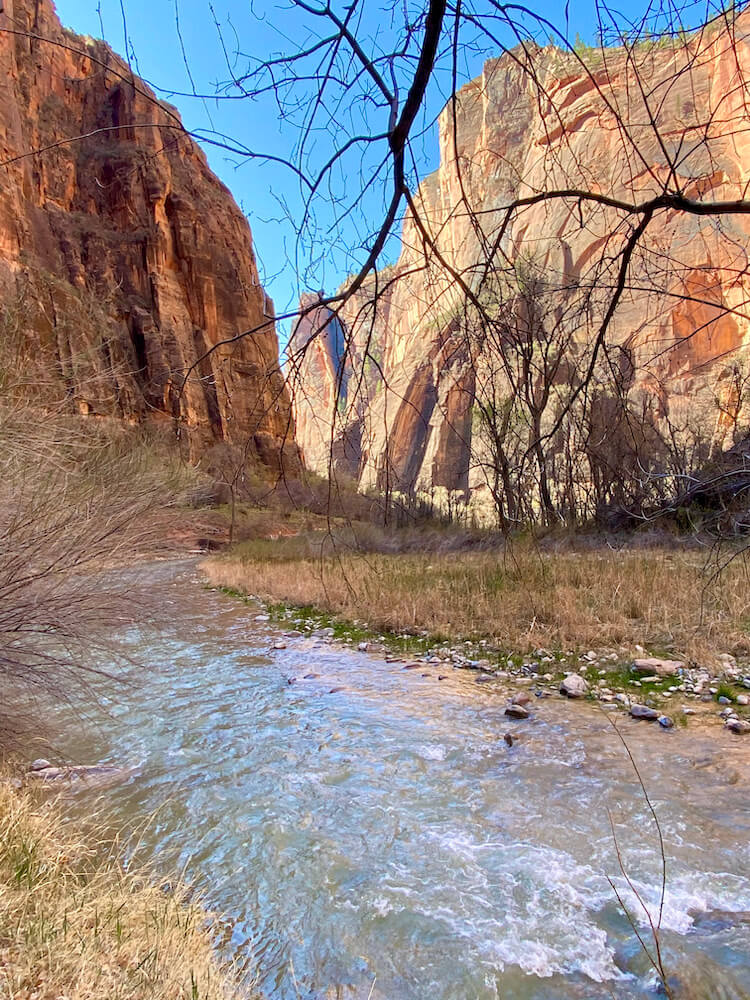

Read more on Western USA travel:
• Best hikes in Zion National Park
• 26 stunning national parks in the western USA
• Three days in Yellowstone National Park
• What to see at Grand Teton National Park
Option 2: Angel’s Landing
Angel’s Landing is a 4.4 mile out and back trail rated as difficult by All Trails.
That’s because it has a 1,604 foot elevation gain on a precarious narrow trail with steep drops to the valley below. Plus, it’s very exposed. And there are no guardrails!
Full disclosure: I haven’t done this hike because I’m kind of a klutz and have a vague fear of heights in situations like this. People have died here. It’s rated as one of the most dangerous hikes in the USA.
The other challenge is that it’s incredibly popular which can mean bottlenecks of people hanging onto the sections of chain behind you and trying to rush you through.
If you’re not dissuaded by all this doom and gloom, go! This trail offers unbelievable views of the valley.
Just don’t be that idiot Instagrammer standing too close to the edge! And please be respectful to fellow hikers ahead of you.
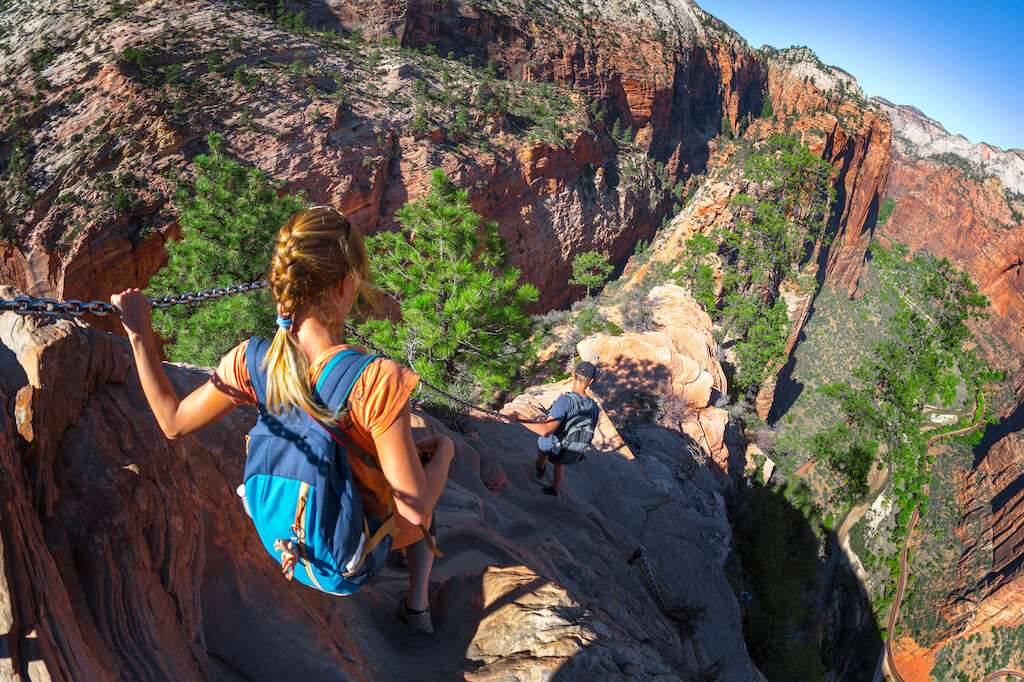
Other Amazing Options for Hikes
If hiking The Narrows or Angel’s Landing isn’t quite your speed, don’t despair. There are so many beautiful hikes for every age and experience level in Zion National Park.
In fact, you can read my post about the 11 best hikes in Zion National Park here.
Observation Point (8 miles) is a personal favorite of mine if you’re looking for a challenging hike that doesn’t feel dangerous!
If you’re an adventure lover, consider booking a half day UTV tour through East Zion slot canyons.
Let a local take the wheel and provide the gear while you try your hand at canyoneering. You’ll go rappeling in six or seven spots!
Check price and availability on the UTV canyoneering tour here.
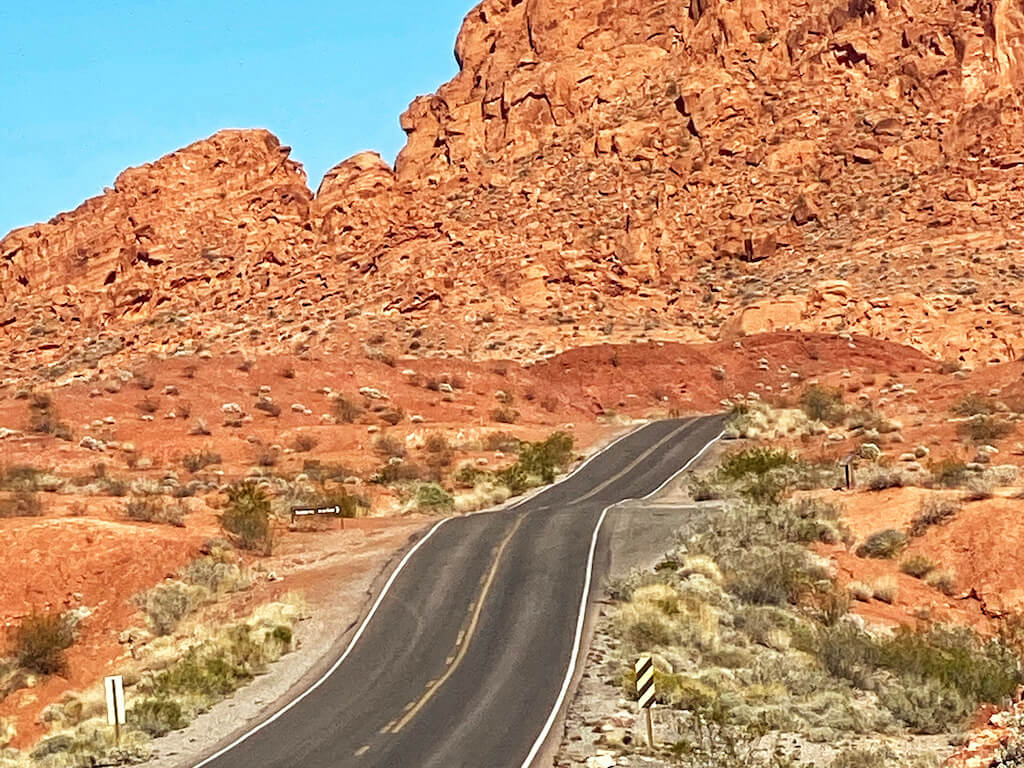
Where to stay near Zion National Park
Option 1: Stay at Zion Lodge
The best thing about staying in the park at Zion Lodge is that you won’t have to wait in the long line of cars to get into the park in the morning.
Just head out! It’s a nice, mid-range hotel and it looks like they’ve renovated the rooms since last time I stayed there.
Check price and availability at Zion Lodge here.
Option 2: Stay in Springdale
Cute little Springdale is nestled up to the park entrance so it’s the prefect base if you want your own place. The historic Rose Cottage sleeps four with two bedrooms and is quaint and cozy.
You can check prices on the historic Rose Cottage here.
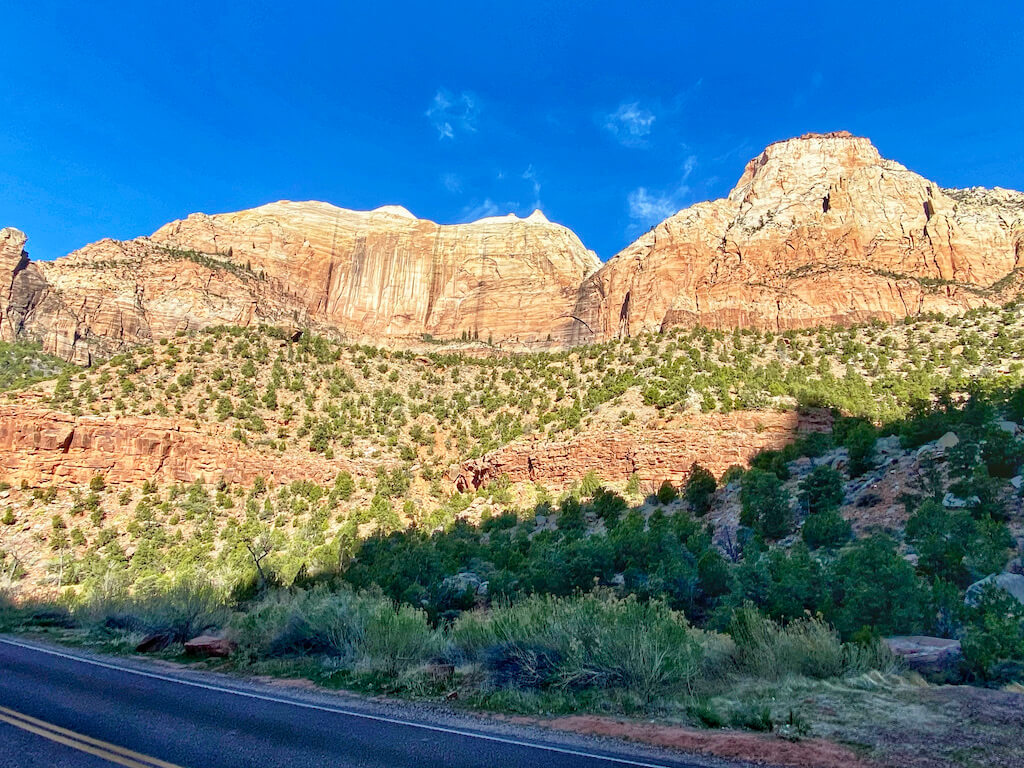
Day 3: Bryce Canyon National Park
It’s on to Bryce Canyon National Park! Bryce is a one hour 45 minute drive from Zion so get an early start to maximize your time if you’ll have just one day here.
Bryce is home to the largest concentration of “hoodoos”—spire-shaped rock formations— in the world. It’s also one of the best national parks for kids.
And you’ll have the opportunity while visiting to take in panoramic vistas of hoodoos while also hiking among them deep in the canyon.
I’ve been here in winter when they were covered with snow and also more recently in spring when they glowed pink in the sun. Both experiences were lovely.
Whichever season you’re here for, you’ll definitely notice the temperature drop from Zion as soon as you arrive.
Bryce Canyon National Park is also compact, much like Zion. And that makes it convenient to see if you only have a single day.
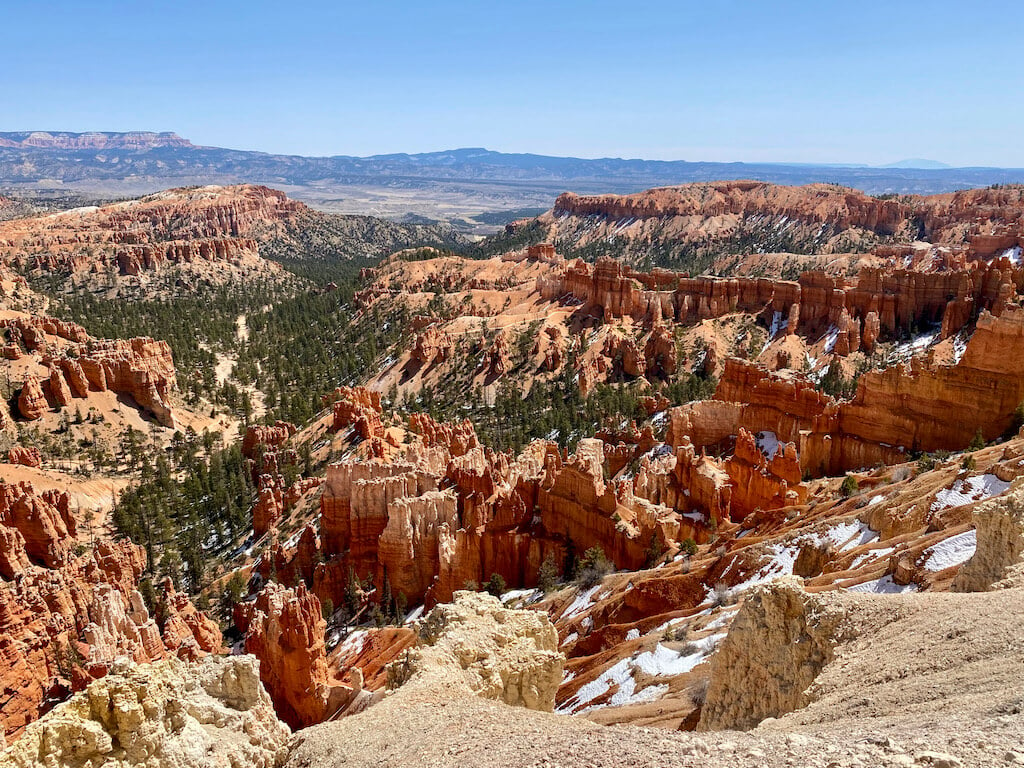
Ogle the Hoodoos from Above
There are a couple of ways to experience the majesty and vastness of the canyon here and they all start with a bird’s eye view. It’s one of the best ways to full appreciate these magical castle-like spires.
If you have time, take the 18 mile Bryce Canyon Scenic drive along Highway 63 from Highway 12 until it ends in the park.
This is a 35 minute drive up to the highest elevations at Rainbow Point and Yovimpa Points.
Just remember that this short drive doesn’t take into account all the time you’ll want to stop at the many scenic overlooks.
Be sure to pull over at Natural Bridge and Agua Canyon at a minimum. The one mile Bristlecone Loop makes a nice one mile loop to stretch your legs here.
Also, you can enjoy the whole Scenic Drive from the comfort of the free park shuttle if you prefer not to drive.
If you’d rather take a break from driving, the shortcut to viewing the hoodoos from above is to simply walk the flat, easy, out-and-back Rim Trail between Sunrise and Sunset Points.
If you walk the whole way, between Fairyland point to Bryce Point, you will come upon a few steep elevation changes. Out and back is 11 miles.
But even a 15 minute walk along the middle flat section of The Rim Trail offers stunning views of the Bryce Amphitheater below.
There is a paved bicycle trail near The Rim Trail but it doesn’t go very far and there are no shoulders for cyclists on the road after that so I’d skip cycling in Bryce.
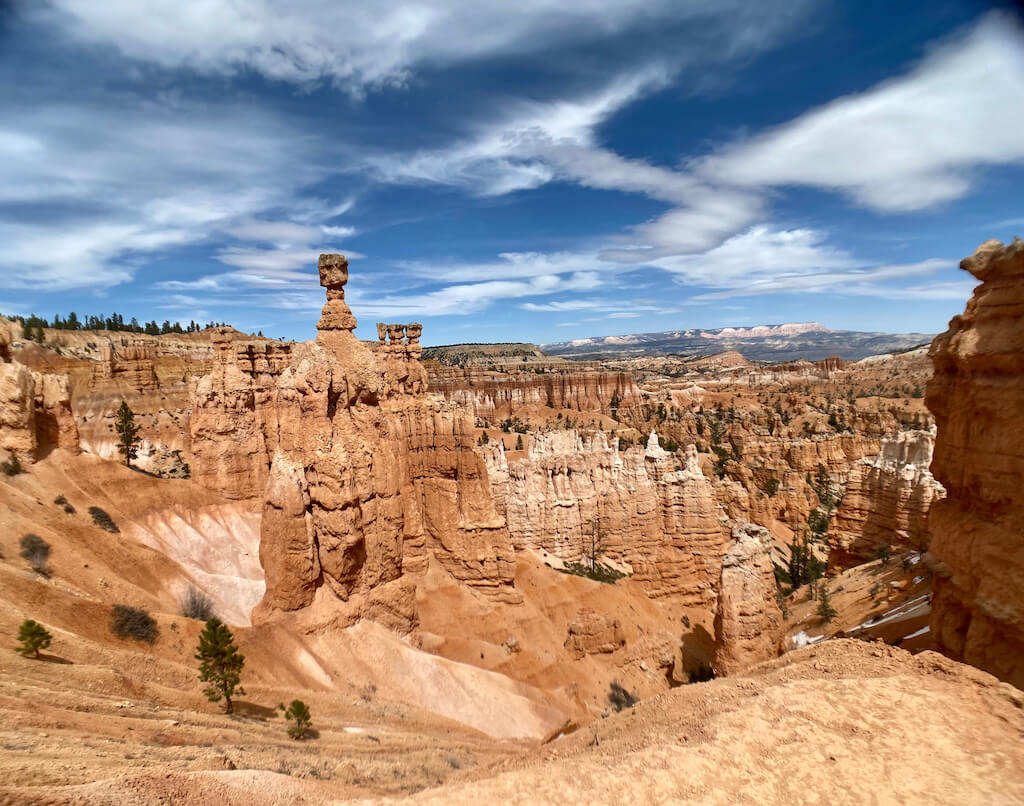
Hike the Hoodoos
There are more than a dozen hikes you can enjoy at Bryce that are rated easy, moderate or strenuous. I highly recommend Queen’s Garden combined with the Navajo Loop.
It’s the most popular trail in the park so again, consider arriving early, hiking first, and then returning to the rim to walk The Rim Trail or enjoy the Scenic Drive.
It can get quite warm here among the hoodoos…even in Spring or fall…which is another great reason to hike early in the day. Bring lots of water and sunscreen!
The Queen’s/Navajo Combination Loop is a moderate 2.9 mile trail with an elevation change of 600 feet and it’s just an unworldly experience!
Of the many hikes I’ve enjoyed around the world, this is one that truly stands out in my memory as a unique experience.
There’s some controversy about whether it’s best to do this hike clockwise or counterclockwise.
We did it counterclockwise, beginning at Sunrise Point which makes for a very steep climb up the canyon at the end at Sunset Point. Oof. Try it the other way!
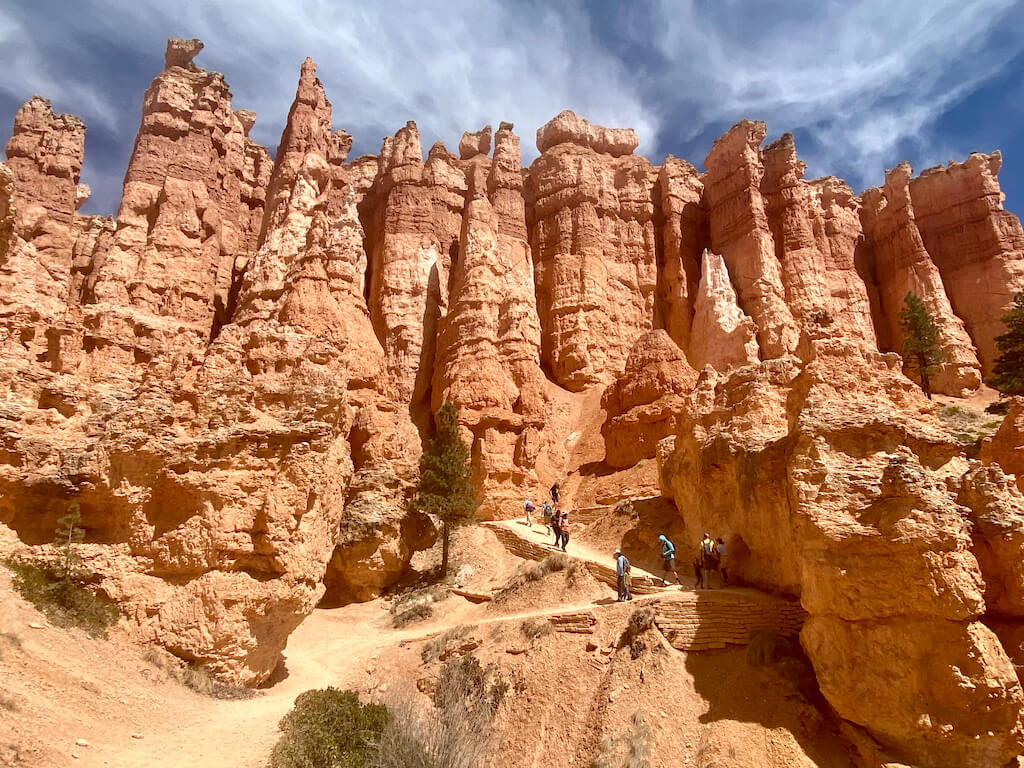
Where to stay in Bryce National Park
Option 1: Stay in the park.
You can stay in historic rustic cabins in the park. This is the most convenient option for a short stay if you can find availability.
Option 2: Log cabin in Henrieville.
We stayed in a gorgeous log cabin in nearby Henrieville (20 minutes to the park).
This cabin was a phenomenal value with its wraparound porch, secluded location and incredible views of the red foothills of the Grand Staircase National Monument. Zero light pollution for watching the night sky, too. Loved it!
Check price and availability on the Henrieville log cabin here.
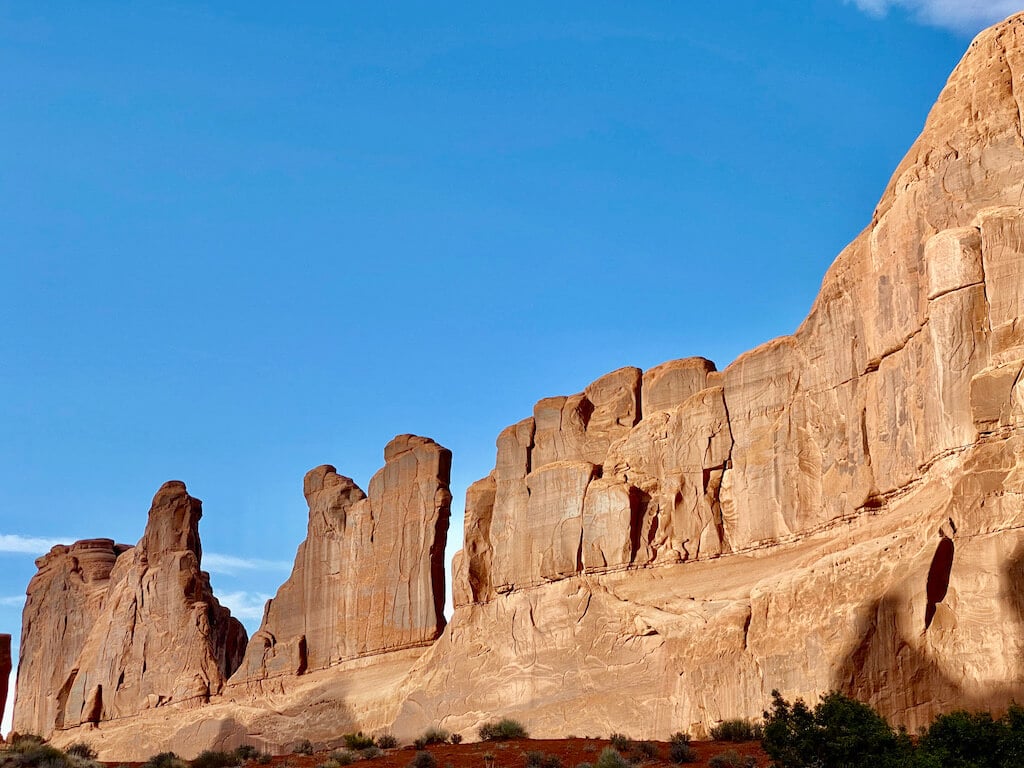
Day 4: Moab
It’s a four hour drive from Bryce Canyon National Park to Arches National Park so dedicate this day to the drive and a hike in Moab.
Many Mighty 5 itineraries hop over to Capitol Reef National Park on the way to Moab, but we did it on the end of our trip on the way back toward Las Vegas. Either way works!
Travel tip: My recommended itineraries usually try to minimize “one night stands” in a place in favor of staying somewhere multiple nights and this one is no exception. I find trips to be infinitely more rejuvenating if I’m not packing and repacking to relocate every night.
Moab makes a great base to explore Arches National Park, Canyonlands National Park, and—my favorite—Dead Horse Point State Park.
If you’d like to see all of these places, too, consider basing in or near Moab for four nights before you head south to Capitol Reef.
They are all easy day trips…within a 35 minute drive from Moab. See “Where to Stay near Arches” below for lodging suggestions.
Moab is a hip little town and a fun place to stay. It has a compact little “downtown” making it easy to base in a nearby neighborhood and walk to dinner.
It was truly striking driving into town and seeing snowy mountain peaks framing the orange sandstone and desert landscapes here.
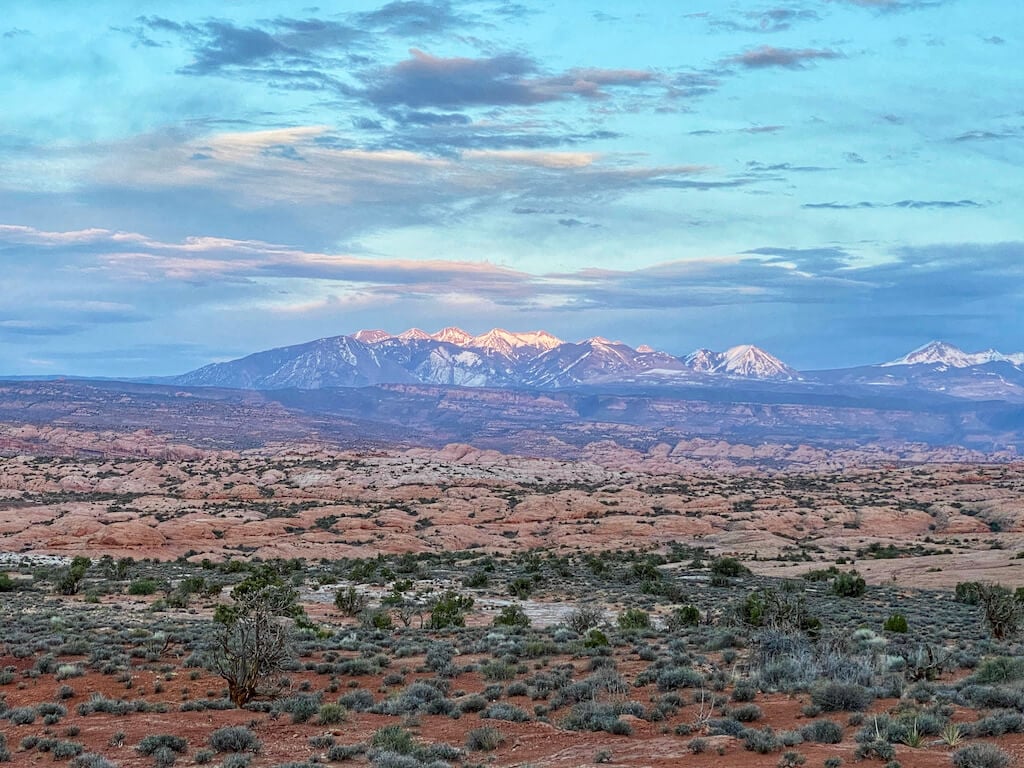
Hike Mill Creek North Fork Trail
The Mill Creek North Fork Trail makes the perfect short afternoon hike with a big payoff to stretch your legs after your drive from Bryce.
It’s just a seven-minute drive from Moab to the Mill Creek Canyon Wilderness Area where the trailhead is.
The trail itself is a 1.8 mile, moderate out-and-back hike with 65 feet in elevation gain.
Wear water shoes as you’ll be crisscrossing a river through a narrow slot canyon to arrive at this lovely waterfall (i.e. “water slide”) cascading into a pool at the end. It makes the perfect spot for a picnic lunch or dinner!
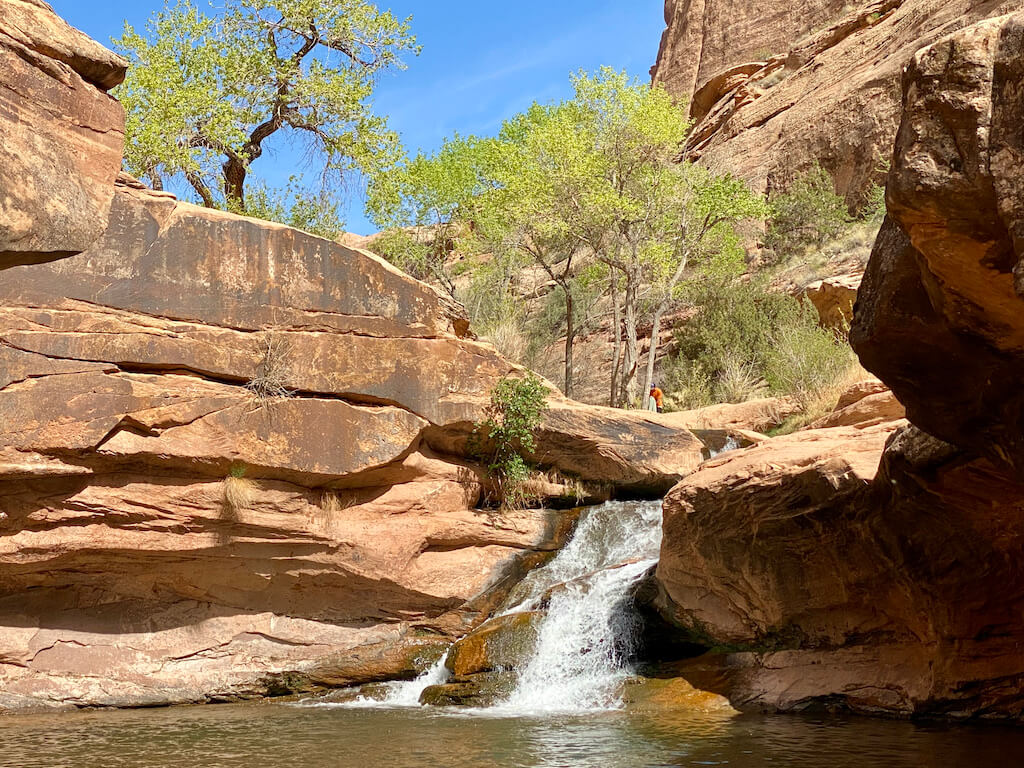
or Roam over Sandstone Domes and Slickrock Ledges
Here are two more ideas for how to spend an adventurous half day in Moab:
1. If you’re a mountain bike enthusiast, rent a mountain bike and check out some of the best off-road trails anywhere.
Moab is world famous for its highly technical Slickrock Bike Trail…recognized as the ultimate mountain biking experience.
But there are plenty of extremely easy and scenic trails for beginners too. Try the Bar-M loop Trail near Arches, for example.
2. Take an offroading 4×4 tour of Hell’s Revenge. This might be the most popular tour in Moab!
You’ll slip behind the wheel of your UTV and follow your guide to the Hell’s Revenge Trail, a roller coaster of steep inclines. (Wait til you climb Devil’s Backbone!).
You’ll see fossilized dinosaur tracks near Lion’s Back and emerge for eye-popping views of sandstone cliffs. This is a great tour at sunset or with teenagers in tow!
Check price and availability on the Moab 4×4 tour of Hell’s Revenge here.
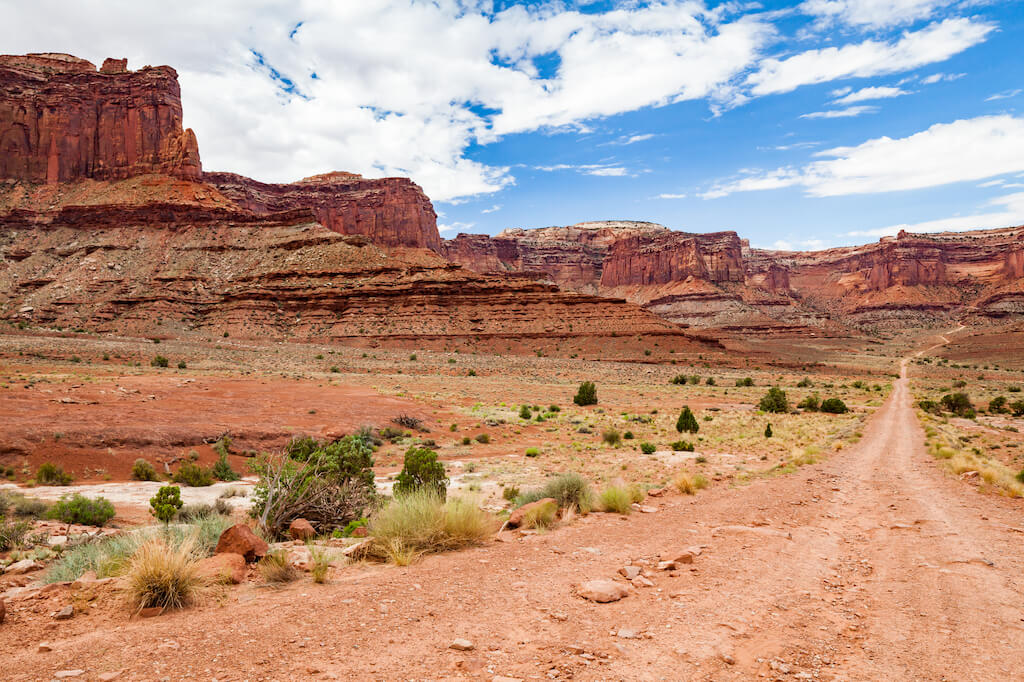
Where to stay near Arches National Park
Stay in Moab.
Moab makes an ideal base to see Arches, Canyonlands, and Dead Horse Point State Park. (There is no lodging inside these parks.)
Option 1: Stay in Wisteria Cottage, a gorgeous one bedroom cottage with a lush garden, bikes, and a hot tub. It’s walking distance to restaurants on Main Street.
Check price and availability on Wisteria Cottage here.
Option 2: Stay at Red Cliffs Lodge, a fab resort with a horse corral, on-site restaurant, and winery. It’s located on a river 25 minutes from Moab and Arches National Park.
Check price and availability on Red Cliffs Lodge here.
Day 5: Arches National Park
Arches National Park was the Utah park I was most excited to see. But it took me a little while to fall in love, to be honest.
It’s another very small park and I found hiking options a little slim, exposed, and underwhelming.
To see the best of the park, you’ll simply drive along the main road, stopping at viewpoints and attractions.
Most of the trails are less than 1 mile to popular attractions like Windows Trail, Double Arch, and Broken Arch. Delicate Arch is a difficult 3 mile trail with an elevation gain of 480 feet.
Remember to bring lots of water and sunscreen. This is a very exposed hike!
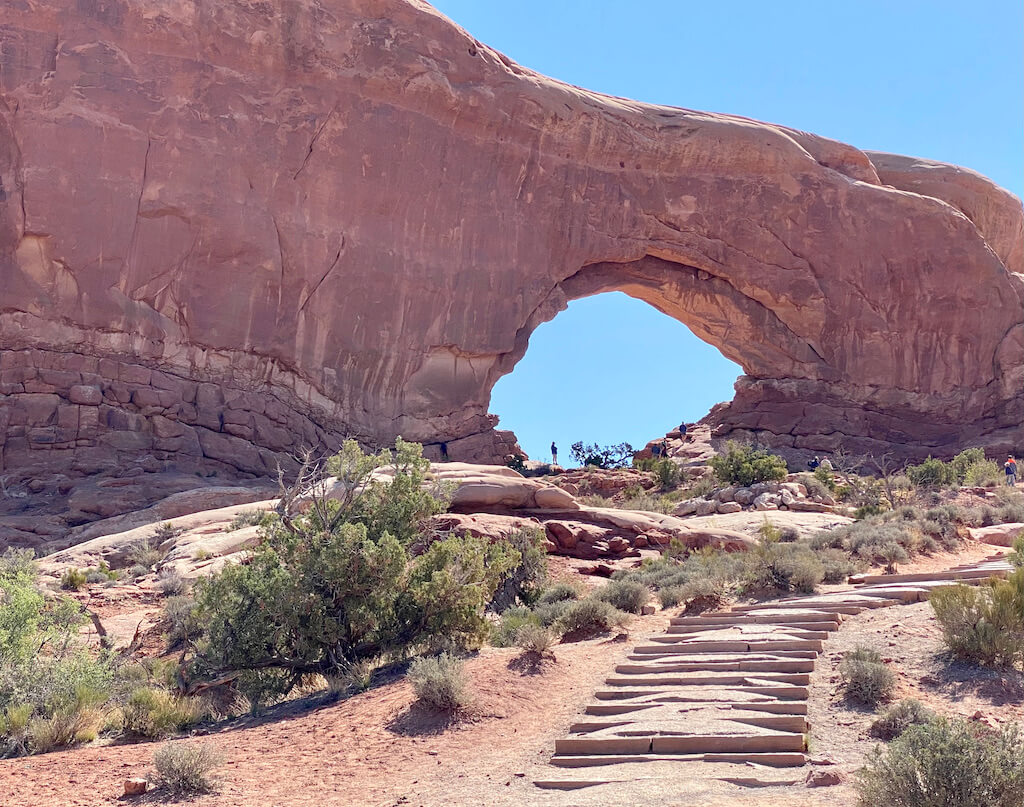
Still, there are more than 2,000 arches here that range from a three foot opening to Landscape Arch, which measures 306 feet from base to base!
This area was home to Native Americans for thousands of years, including Archaic people, Puebloan, Fremont, and Ute peoples.
Rumor has it that you can view some of the petroglyph panels they’ve left here just off the trail to Delicate Arch as well. (Look for a small trail that forks off the main trail.)
So when did I finally fall in love with Arches National Park?
At sunset. That is when the spirit and silence of the place moved me as the kaleidoscope of pastel sandstone cliffs and arches danced in the warm evening sunlight.
I highly recommend that you time your visit to spend sunset in the park. It’s memorable.

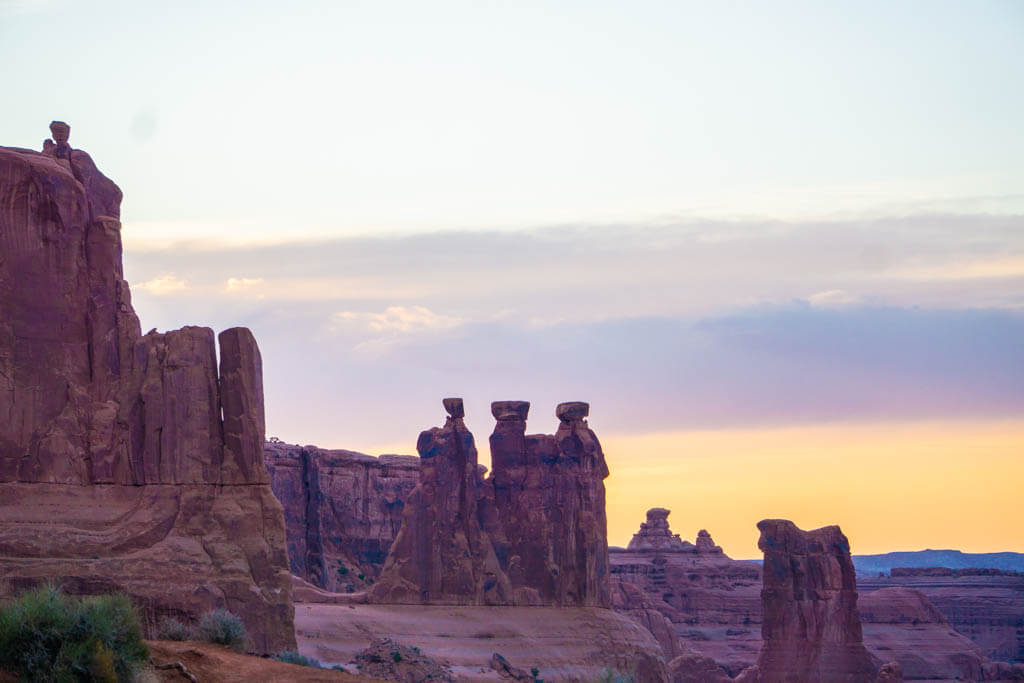
This is also Dark Sky country. Plenty of photographers head into the park in the dead of night for spectacular astrophotography with no light pollution.
Day 6: Canyonlands National Park
If Arches, Bryce, and Zion are Utah’s most touristed parks, Canyonlands and Capitol Reef are its most under-appreciated.
The good news is that you will encounter far fewer tourists here, which makes it truly a magical crowd-free experience.
Canyonlands National Park offers an incredible window into millions of years of geological history of this country.
Most of the rock here came from distant mountain ranges like the Rockies and even the Appalachians!
Unlike many of its sister parks in Utah, Canyonlands is huge and sprawling.
In fact, it’s divided into four areas: Island in the Sky, the Needles, the Maze, and the Rivers. And you’d have to drive several hours to access each one.
The easiest way to visit via Moab is to head to Island in the Sky, which is compact and easy to see in a day.
In fact, you can tour the entire mesa via a 34-mile roundtrip scenic drive. (Download the audio guide ahead of time. For $12.99, you also get the one for Arches National Park.)
If you have a full day, choose this option. You’ll have time to visit every overlook, hike several trails and picnic at White Rim Overlook or Upheaval Dome picnic area.
If you don’t have a full day, here are two ideas.
1. See it as a half day tour from Moab and let someone else do the driving. This is a great place for a 4×4 tour.
You’ll be picked up at your lodging in Moab, meander along the river, explore Native American rock art in the cliffs, and see all the best parts of Island in the Sky.
Check price and availability on the guided 4×4 tour of Canyonlands here.
2. You could also plan on a half day at Canyonlands and a half day at Dead Horse Point State Park (below). It’s located conveniently just minutes from Canyonlands. Dead Horse Point State Park makes a great spot for sunset!
Here are a few highlights that you can fit into a half day visit:
See Mesa Arch at Sunrise
Get an early start from Moab. Plan on about a 35 minute drive.
Some things are truly worth getting up early for and seeing Mesa Arch in Canyonlands National Park at sunrise is one of them!
Just remember to fill your car with gas in Moab first as you won’t find any gas stations in these parts.
Mesa Arch is a spectacular natural stone arch perched on the edge of a cliff with a stunning vista of the vast canyon below. This view offers a huge pay-off for an easy half mile hike!
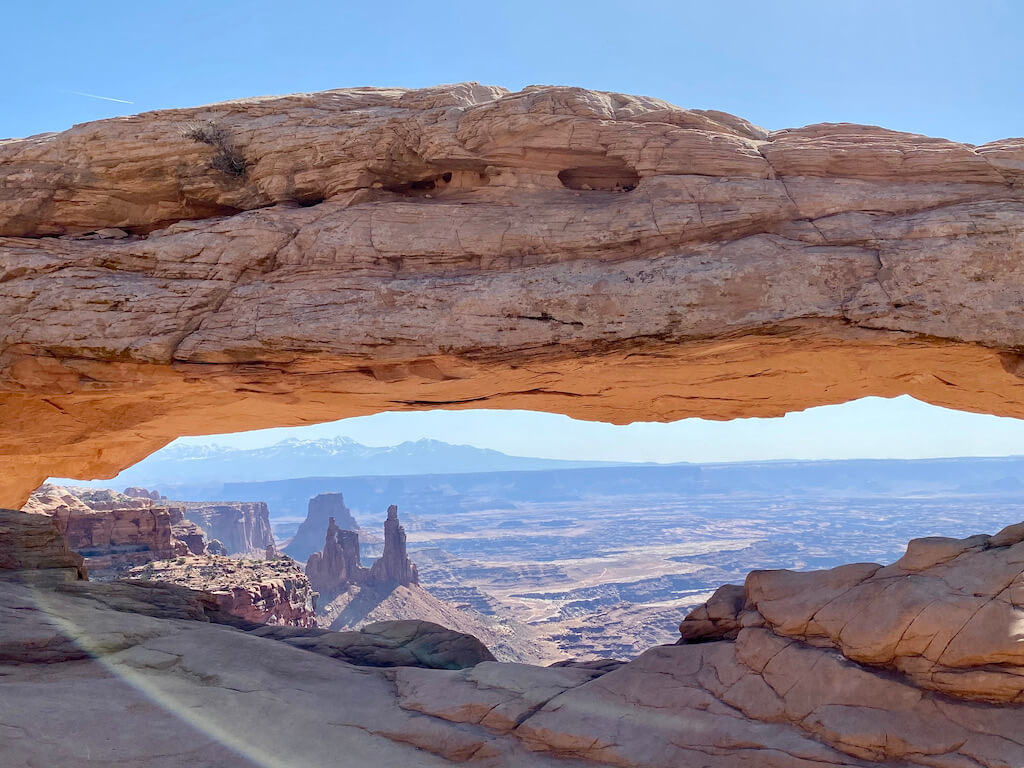
Stop at Grand View Point
Grand View Point is about a 15-minute drive from the visitor center (or 60 minutes from Moab) and it offers a truly unusual view of the geology here.
The viewpoint, at 6,080 feet elevation, allows you to look out at distant mountains, basins, canyons, and the White Rim Road.
This is also a nice place for a hike. While the Grand View Point Trail is just two miles out and back, plan on 1.5 hours to follow along the canyon edge here as you gawk at panoramic views.
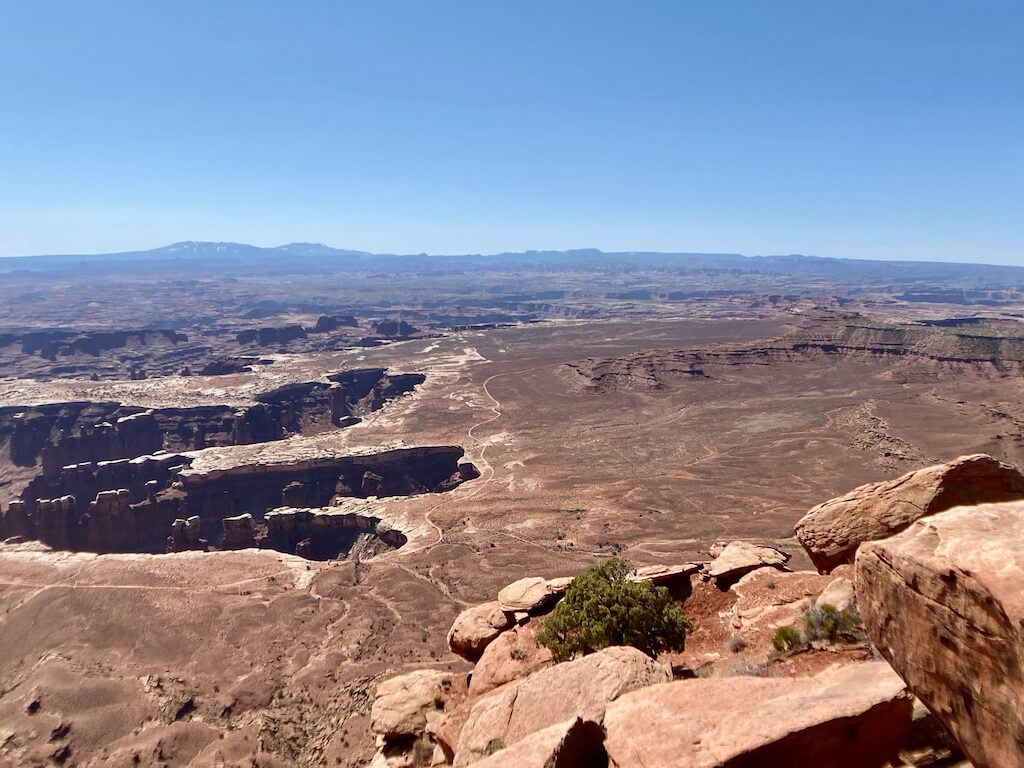
Visit the Green River Overlook
The landscape you can see from the Green River Outlook is otherworldly! This view is taken with my telephoto lens but the views here are vast and sweeping.
The Green River Overlook is a southwest-facing viewpoint and offers one of the best views of the Green River cutting new canyon through the sandstone below as it has done for thousands of years here.
It’s also a popular place for sunset. Truly mesmerizing!
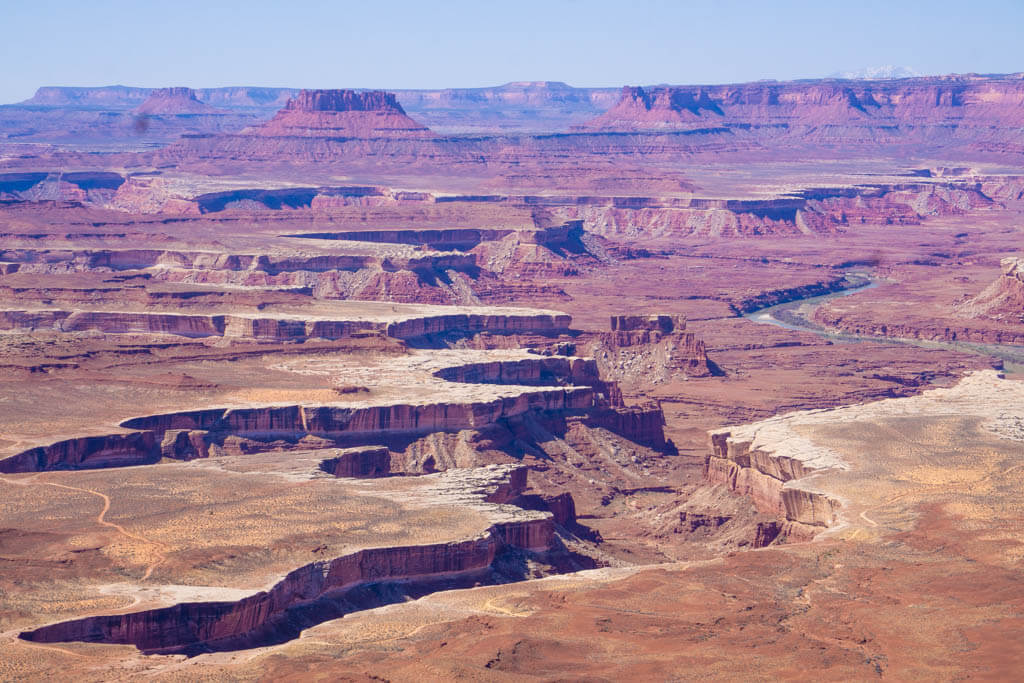
There are 18 hikes in Island in the Sky that range from short mesa trails with minimal elevation change to long, strenuous hikes that descend via switchbacks to the White Rim or beyond to one of the rivers.
It’s all up to you!
BONUS: Dead Horse Point State Park
I had never heard of Dead Horse Point State Park until I learned it was close to Canyonlands (just a 15 minute drive) and a local recommended we visit.
We loved it so much that we returned for a second day of mountain biking.
I’ve called this a bonus day since it will count as a ninth day in this itinerary and it’s not one of the Mighty 5.
If you only have eight days, you could also swap it out for one of the two days I’ve allocated for Capitol Reef National Park below.
Note: Your National Parks Pass doesn’t include access to this state park. The entrance fee is $20 per vehicle (and well worth it).
So why is it called Dead Horse Point State Park? Legend has it that cowboys in the 19th century used it as a natural corral for wild mustangs.
They rounded up the horses, herded them onto the point, and fenced them in with branches and brush.
Then they selected the ones they wanted and left the rest to perish of heat and thirst with no access to the Colorado River 2,000 feet below. Ugh. I know.
Despite its unseemly name and origin, Dead Horse Point State Park offers spectacular views of wide open spaces. It reminded me a bit of The Grand Canyon.
Millions of years of geological activity—think ancient oceans, freshwater lakes, streams, and wind-blown sand dunes—left deposits of sediments to create the colorful “islands” of canyons you’ll see rising out of the hot, dry desert here.
Stop at Dead Horse Point Overlook
If there’s one thing you must do at this park, it’s take time to enjoy the view at the Dead Horse Point Overlook. It’s one of the most photographed vistas in the world and you can see why…
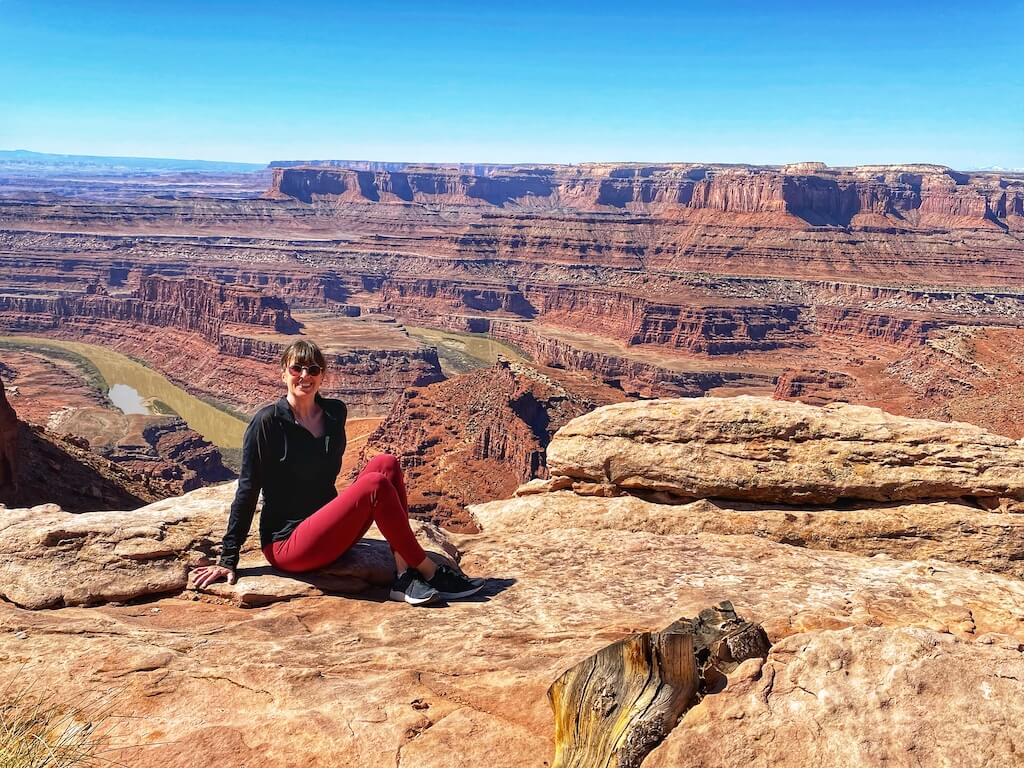
After that, you can walk the East Rim Trail System…It’s an easy, flat trail along the eastern side of the mesa (2 miles one way). Or, try one of the more moderate trails, like The Bighorn Overlook Trail or the West Rim (2.5 to 3.5 miles one way.)
Get on a Mountain Bike
Confession: I’m not a mountain biker! But Steve is and he really, really wanted to check out the mountain bike trails here at Dead Horse Point State Park so I agreed to give it a go.
The Intrepid Trail System here offers nearly 17 miles of incredibly scenic single-track trails. These wind through juniper and pinyon trees, over slick rock and the views are to die for.
There are three loops that range from one to nine miles and are graded according to difficulty so you can stay in your comfort zone if you’re a novice rider like me!
You can rent mountain bikes right here at the park at Bighorn Mountain Biking which makes it super convenient. Or get a guided mountain biking tour by a local.
Check price and availability on the guided mountain biking tour here.
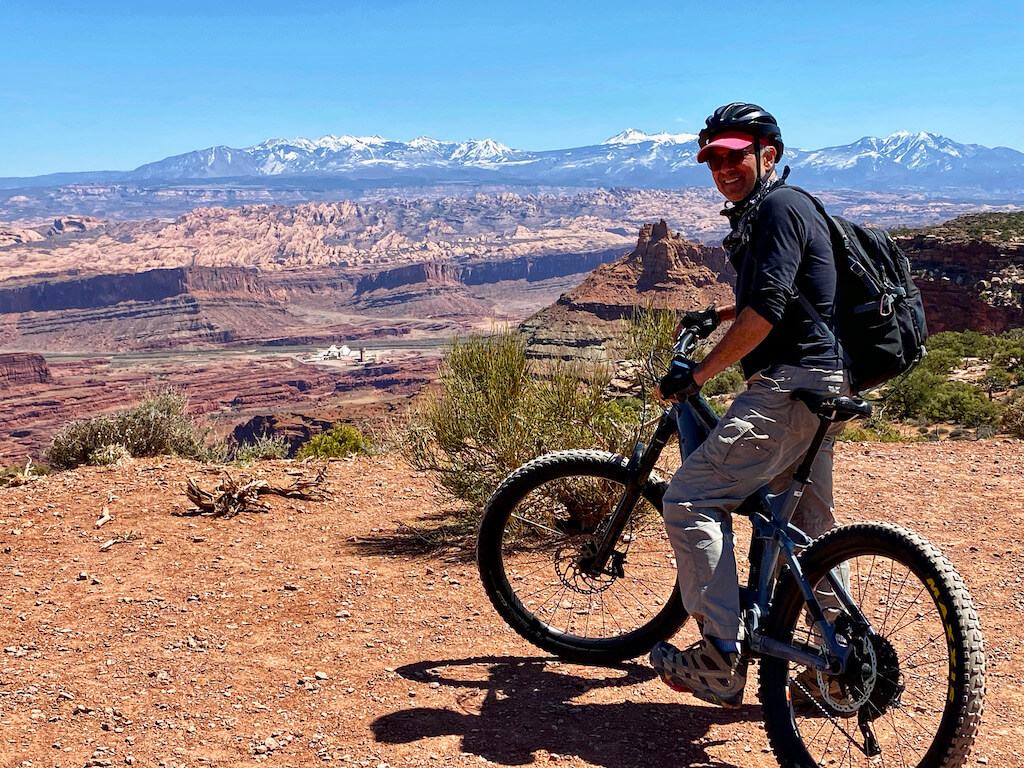
Day 7: Explore Fruita at Capitol Reef National Park
Have you heard any of your friends talk about their visit to Capitol Reef National Park? Me neither. And wow, are people missing out!
Many people visit Capitol Reef as a drive-by, glancing out the car window, on their way to better-known parks. But—especially if you’re a hiker—I say: Give this park two days on your itinerary. This is stunning country!
You’ll find cliffs, canyons, domes, and bridges here. And lots of unique history!
Hunters and gatherers called this area home around 500 CE, first foraging and then farming corn, beans, and squash. Petroglyphs on rock walls and painted pictographs still remain from this era.
The Mormon Latter Day Saints and other pioneers settled here in the 19th century, planting apple, pear, peach, and orchard trees in what is now the heart of the park and called the Fruita Rural Historical District.
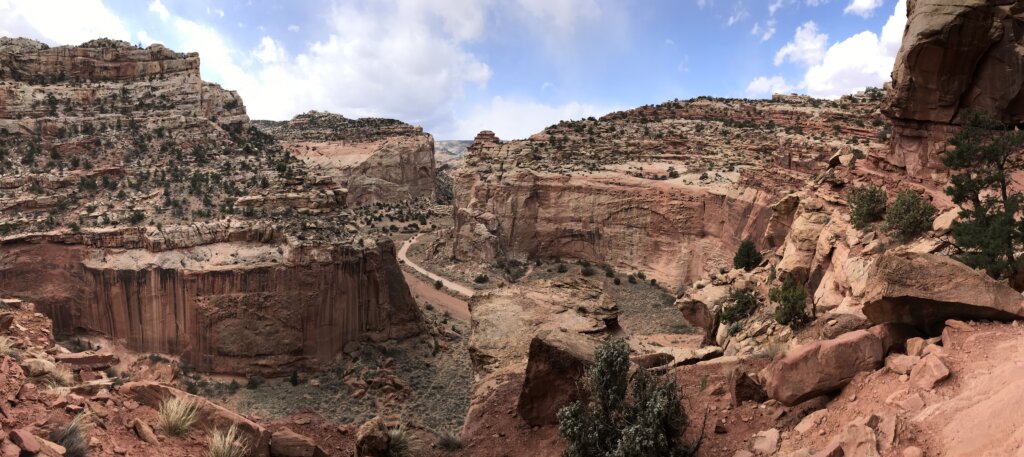
Drive the Scenic Drive
Plan on about 90 minutes to drive the Scenic Drive in the park, including two dirt spur roads, Grand Wash and Capitol Gorge.
You’ll meander past the sheer Wingate sandstone cliffs, red shale Moenkopi formations, the Slickrock Divide, and the yellowish-gray Shinarump sediments.
At stop #10, you’ll see the white rounded dome that gave Capitol Reef its name. It looks a bit like the U.S. Capitol building!
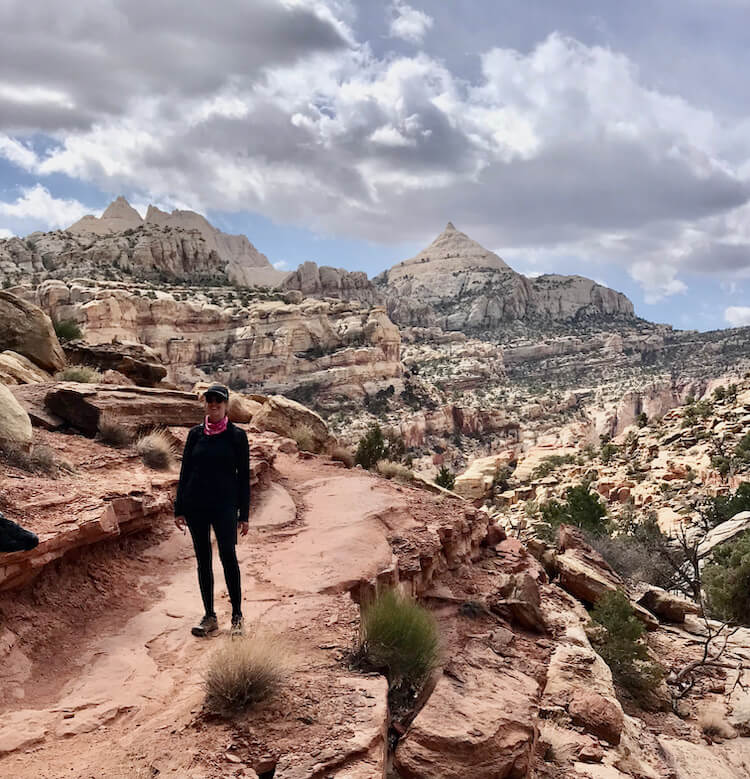
Have Pie at Gifford House
In the little “town” of Fruita (it’s basically just a few buildings), be sure to stop into Gifford House for a piece of fruit pie.
This historic home was built in 1908 by a polygamist who lived in it for eight years, later selling it to a second family of farmers who occupied it for the next 41 years.
But today, it’s best appreciated as the place to get a delicious piece of fruit pie. Bakers from nearby Torrey make the pies and deliver them daily. (I like my pie slightly tart with a hint of sweetness and this pie was on point.)

View the Petroglyph Panels
It’s so amazing to see petroglyphs with your own eyes!
These petroglyphs are by the Fremont Culture, the hunter-gatherers I mentioned earlier that lived here for 1,000 years. You can see the Fremont Culture petroglyphs along Utah State Route 24.
Just walk up the two boardwalks. Depending upon the time of day, the sun can wash them out so you may need to look closely.
Bring a pair of binoculars. If you’re patient, you’ll begin to spot them all over the granite face.
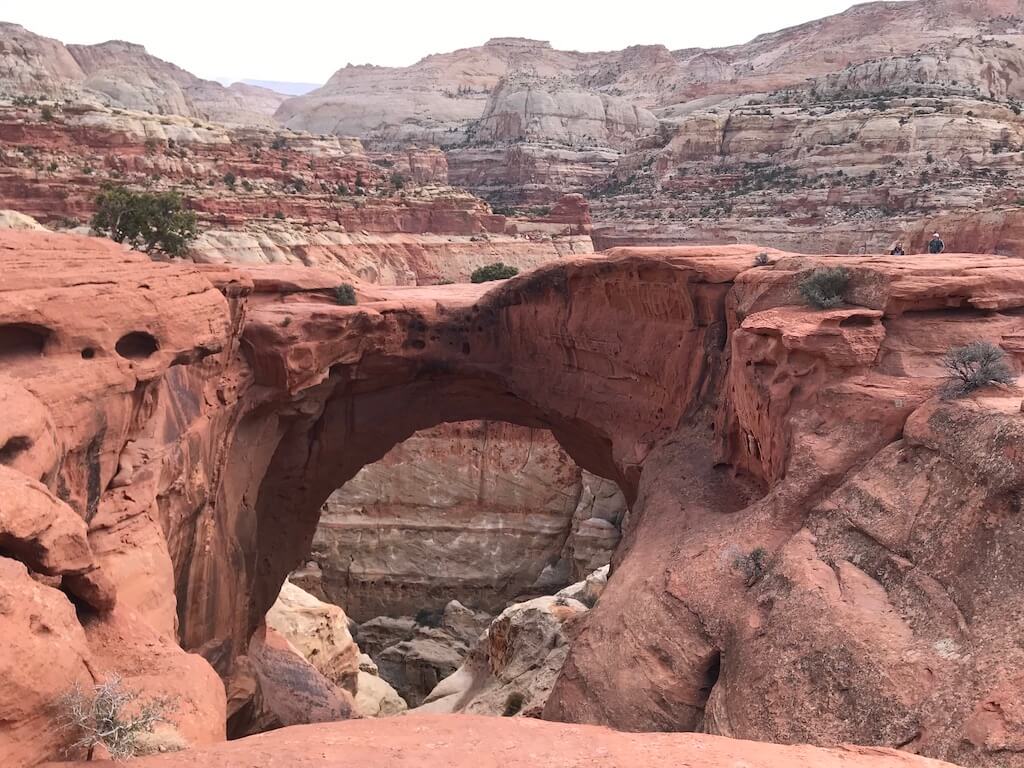
Where to stay near Capitol Reef National Park
There is no lodging in the park.
Option 1: Stay at the Sweetgrass Studio, a historic but modern cozy studio in Bicknell, just 12 miles from the park. This was one of my all-time favorite stays! I could happily live here.
Tons of artistic character, inexpensive, and just above a delightful coffeehouse & gallery. Seriously, don’t look any further. The photos don’t do it justice.
Check price and availability at the Sweetgrass Studio here.
Option 2: Fuita Campground in the park. There are 71 sites. Reserve ahead!
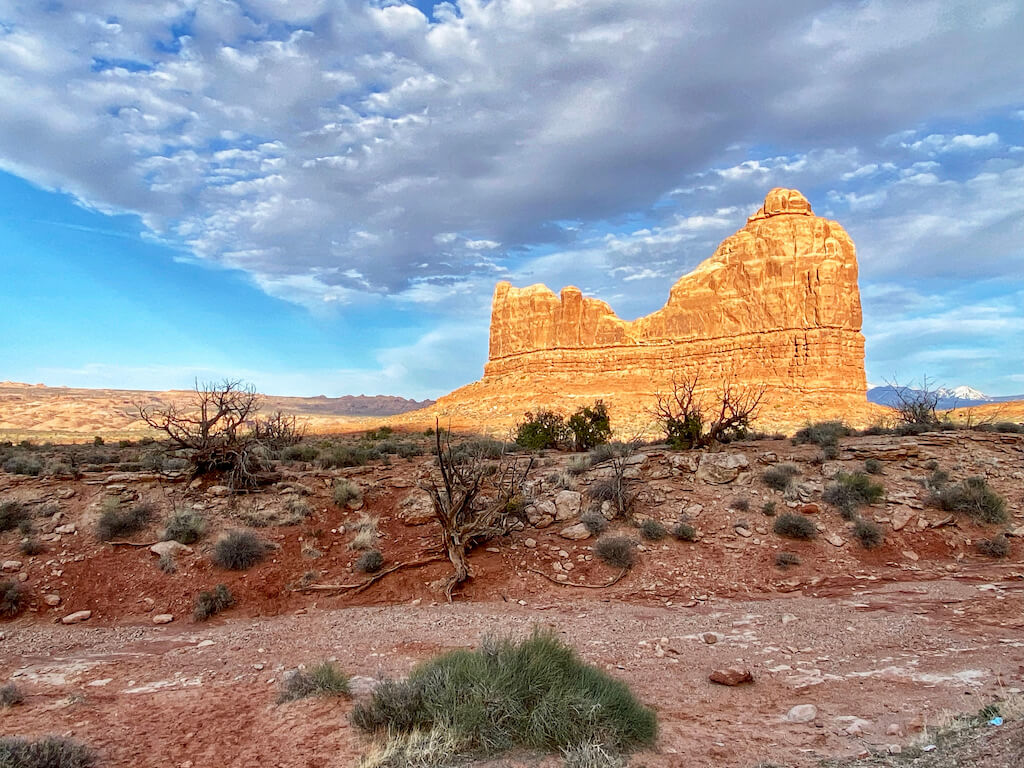
The Grand Staircase: A Geological Wonder
The thing that surprised me the most when as we meandered our way through these 5 national parks on our Utah road trip was how incredibly varied the landscapes were.
I thought the scenery might start to look all the same but honestly, I had the exact opposite experience. I was enthralled by how distinct and beautiful each park was from the next in such a relatively short drive.
From deep chiseled canyons framing clear rivers to stark orange granite cliffs, these national treasures in Utah will take your breath away.
In part, that’s because this region is known as The Grand Staircase (which is distinct from Grand Staircase Escalante, a national monument that protects The Grand Staircase and other fragile geological treasures in this region).
The Grand Staircase is essentially a sequence of sedimentary rock layers that stretch from Bryce through Zion and all the way into the Grand Canyon.
It’s like a layered “cake” of pink cliffs, grey cliffs, white cliffs, vermillion cliffs, and chocolate cliffs—so named by a geologist in the late 19th century—that reads like a history book chronicling geological history for over 600 million years!
And not just that, but it’s all intact…making it unlike anywhere else on earth! In most places around the world, this kind of precious history has been damaged and distorted due to the rise and fall of mountains, glaciers, etc.
But astonishing fossils have been preserved in this unique sedimentary rock throughout millenia.
The best part? You are going to see this incredible “cake” change before your eyes as you drive!
Day 8: Hike in Capitol Reef National Park
The hiking here is phenomenal! The top two hikes here are Hickman Bridge Trail (moderate, 1.7 miles, one hour) and Cassidy Arch Trail (strenuous, 3.1 miles, one hour 45 minutes).
You deserve a piece of pie after hiking one of these! We hiked Cassidy Arch Trail (666 feet elevation gain) and the views were just more and more spectacular as we wound our way to the top.
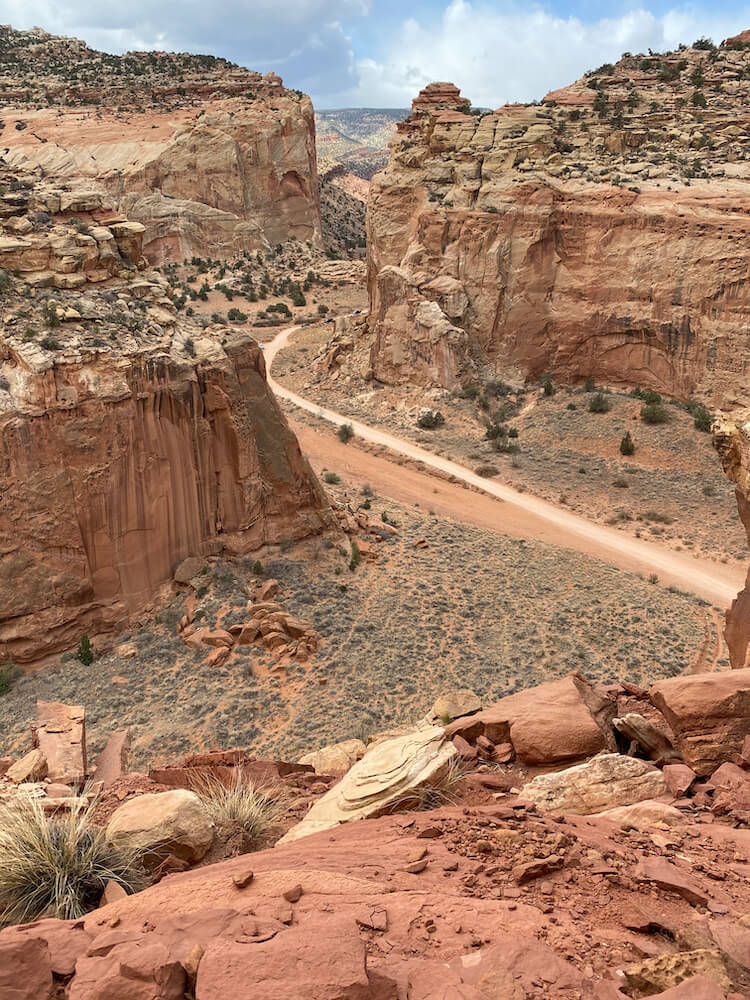
But you don’t have to hike a strenuous trail for a big pay-off here.
You can enjoy dramatic canyon views from the easy Goosenecks Trail (.1 mile), sunset panoramas at Sunset Point (.4 miles) or a relaxed stroll and picnic next to Fremont River (easy 1 mile with a steep climb to a panorama point at the end).
The unique beauty of Capitol Reef was the biggest surprise of our visit to The Mighty 5…especially since we saw just a handful of hikers on the trail with us during prime travel time in spring.
Utah Parks Travel Tips
1. Book early! Zion and Arches are particularly busy in late spring and summer. For best selection of hotels and vacation rentals in high season, book three months out.
2. Bring more water than you think you need! Visitors routinely underestimate how easy it is to get dehydrated in Utah. Plan on at least one gallon per person per day. (Some would say more!)
2. Arrive early to beat the rush and beat the heat. Parks are so much more fun crowd-free. Visiting just before sunset works well too.
3. Get an annual parks pass to save money on entrance fees.
4. Know your limits. The best thing about US national parks is that there are plenty of easy, moderate, and strenuous hikes. Avoid accidents and overexertion by choosing appropriately.
5. Be part of the solution, not part of the problem. Be patient during busy season at the park. Pick up litter. And always be respectful to wildlife and consider your impact on fragile plants and ecosystems.
Road Trip to Utah National Parks
It’s a wrap! Hopefully, you feel inspired to see the Mighty 5!
Interestingly, back in 2012, it was the Utah Office of Tourism that came up with the idea of a “Mighty 5” campaign to bring more visitors to the parks. They were tired of the state being confused with Arizona!
And the campaign was a smash hit. After it aired, they saw a double-digit increase in visitors most of the years since. Unfortunately, Utah national parks are experiencing the opposite problem now.
In summer of 2021, the gates at Arches National Park typically closed by 8 am because parking lots were already full.
You can be part of the solution in preserving these treasures by visiting slightly off-season, before dusk on the day you visit, by riding a bicycle instead of driving a car…and also by spending more time in less visited parks like Capitol Reef.
However, you choose to see the Mighty 5, I wish you a most excellent adventure.
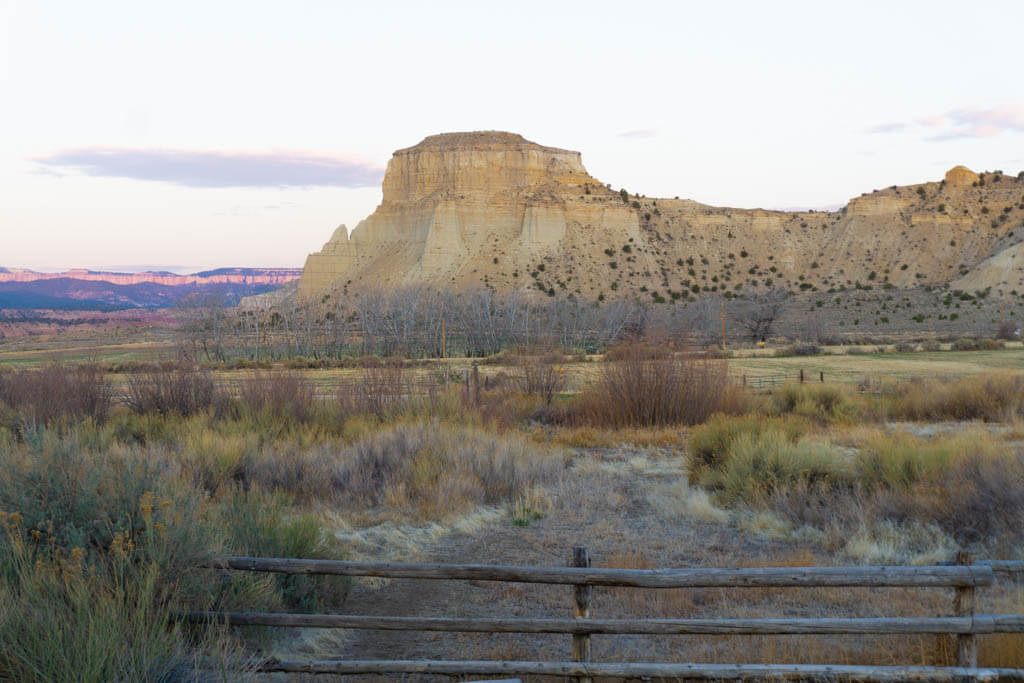
Liked this post? Pin it now to save it for later!
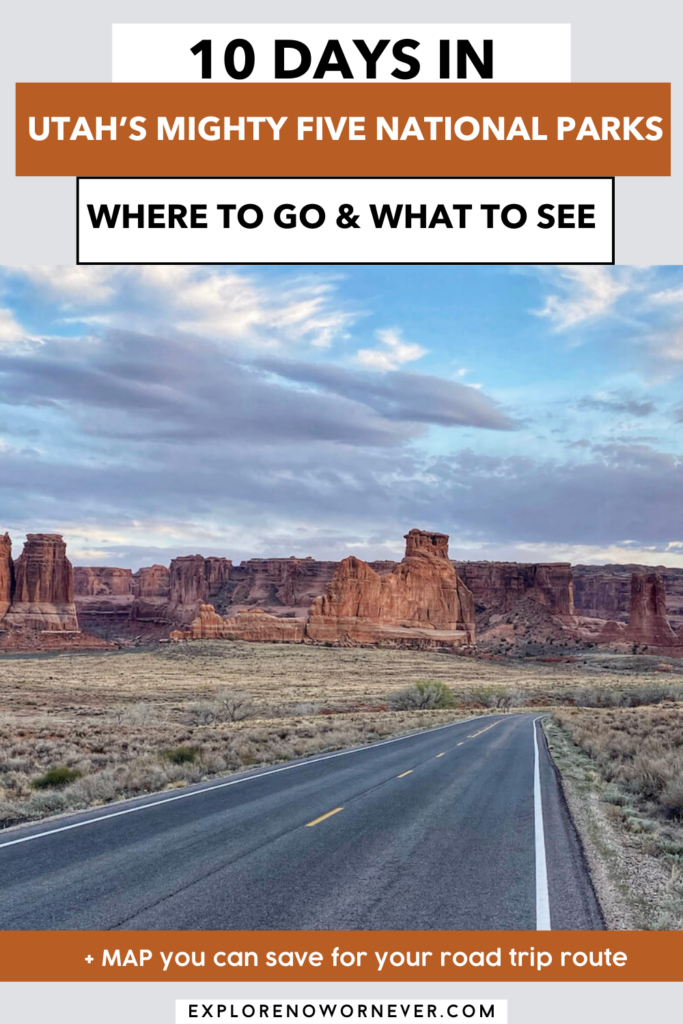
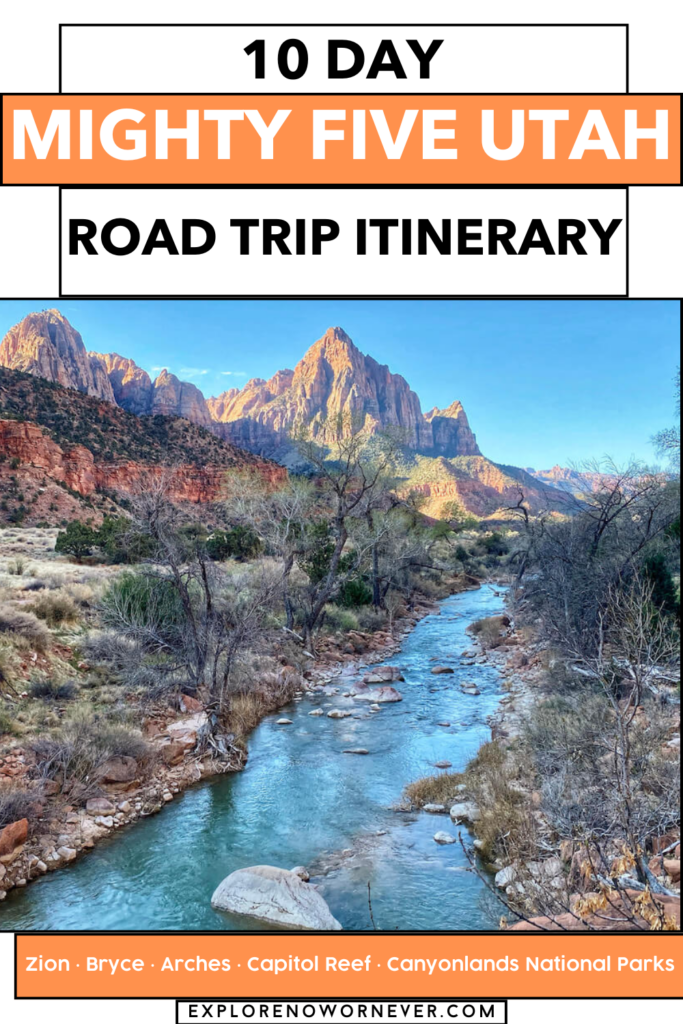
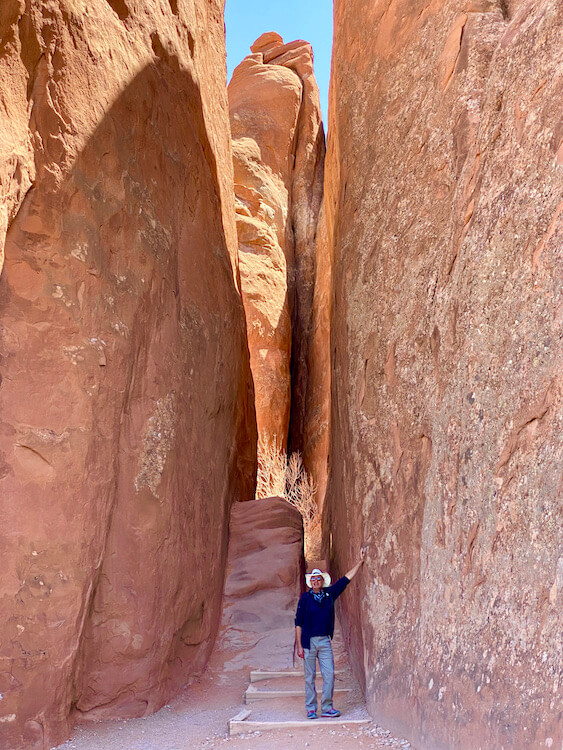
Great post, Chris! I am feeling inspired to go again. We’ve never done them all in a row, but maybe next time. I saw your Mesa Arch photo and have one of my son at 5 in front of the arch and I realize that was 30 years ago. I just wanted to add that an annual senior pass is only $20 for all the national parks and only $80 for a lifetime senior pass. Also, I hiked the narrows when I was younger and the water was hip high in the summer. Probably the best time to try this hike is in the late summer or fall. We have seen the river as a torrent in spring and the hike was closed. Can’t wait to go again! Thanks for all the great tips!
Lisa, yes! The lifetime senior pass is such a great deal. Steve officially qualified for one this year and is so proud of his pass haha. Thanks for the tips on The Narrows!
Awesome article! I have spent many vacations at all of the big 5! I was pleased to see you focus on Capital Reef one of my favorite places…Escalante as well which has fantastic hikes. 22 years ago a friend and I helped gurney a woman’s dog who had burned its pads on one of the trails. It was September but very hot ….remember to protect your furry friends!
Thanks so much, Ed, for sharing your lovely story as a good samaritan. It makes my day when a reader who knows a place well feels I’ve done it justice. And yes, Capitol Reef is amazing!